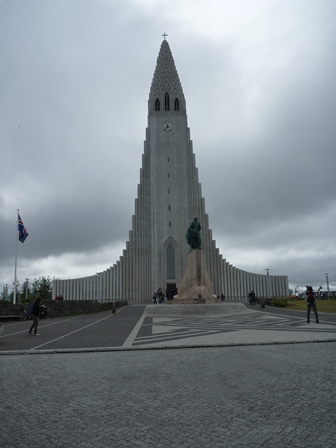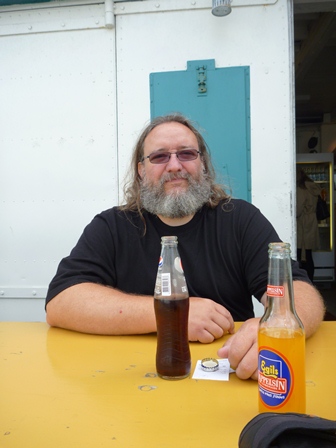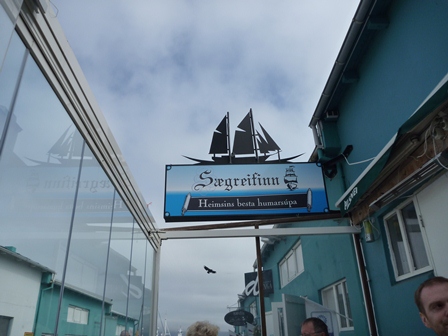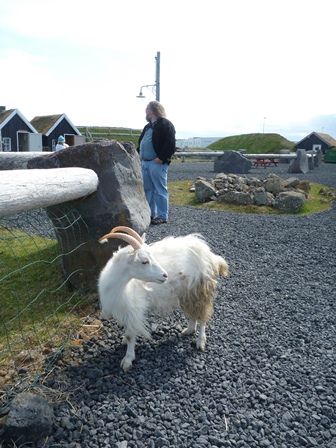
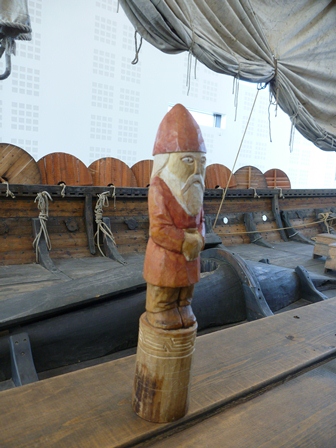
In June and July of 2011, Neil and Karen embarked on a trip that we've been hoping to go on for the last 3 years. Neil is taking a degree in Archaeology and one requirement is to do a class taught hands-on in the field (a field school). Although he had applied to an Icelandic school a couple of years ago it was reduced that year and he did not get a spot. Instead we went on a trip around Iceland. This year, we were looking at a field school in Gotland run by Dan Carlsson who had done the Fröjel dig. Since the field school did not require any formal background in archaeology, both Karen and Neil signed up for the 4 week program. This is the record of our trip.
A note about our traveling companion, Snorri. Snorri was carved by Steve from the Dark Ages Recreation Company, of which we are also members. Snorri has traveled to many places in the world now, with various members in the group. Neil is responsible for DARC's webpages, and is considering giving Snorri a page of his own on the site.
We spent the day packing and cleaning house, left the doggie and
got on an Airways Transit
van around 5. When we
checked in we learned that the Executive Comfort seats we had bought
had been upgraded to Saga Class, with no extra charge - nice!
Neil was
surprised at how run down Terminal 3 looked, since he remembers when it
was new. We had dinner at the airport - lobster soup and a greek
chicken salad for Karen, lobster soup and a burger for Neil.
Alda, from the former
Iceland Weather Report has moved to Facebook with a
fan page for IWR, and she recently posted a picture of the
IcelandAir
plane with the Eyjafjallajökull name on it. Apparently, IcelandAir recently renamed all
of it's planes with the names of volcanoes in Iceland. Planespotters.net has a list of
all the planes thus far. Our flight over was on Hengill. We
attempted to sleep - it might have worked in brief moments at a time -
4 hours had passed before Karen felt compelled to check the time.
Still better than our last trip over and leaving us in better shape.
We landed in Iceland
at 6:25am - a four hour time adjustment, which is always a bit of a
shock. We picked up our rental
car and headed over to
the Northern Light Inn
to check in. We didn't feel too badly throughout the day (this part of
the trip usually just kills the first day for Karen) so we wandered
around quite a bit. We started with the Blue Lagoon for an hour to try
soaking away the jet lag. We then visited the Vikingaheimer museum again
to see what had changed there. This is a new museum, opening just
about the same the world economic collapse in 2008 that hit Iceland
particularly hard. They had added some computers with more in depth
information, a sail on the boat, and a burial with a new section on
religion. A large room that had felt empty with few exhibits was
closed, and the exhibits moved into the other rooms which makes things
feel more complete. It still needs some more depth. There is also a
new exhibit out front with animals that was amusing. It is nice
to see how this museum has grown over the years and we look forward to
more changes in the future.

|

|
|
| Various animals looking around | Snorri tried to get on the boat again |
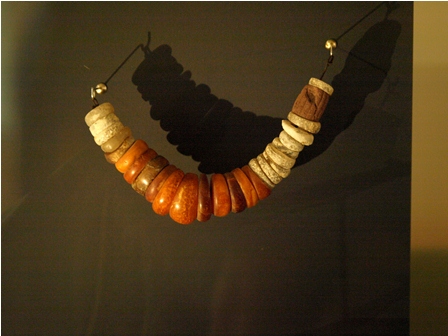 |
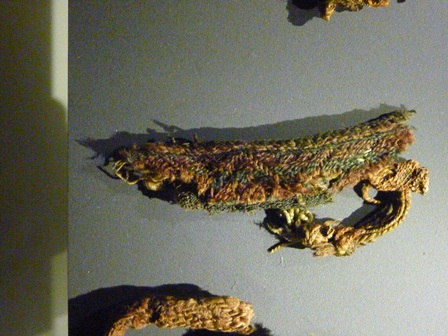 |
|
| Amber and rock beads |
Tablet woven border |
Dinner at the hotel - the Northern
Light Inn. Neil had catfish in butter *shudder* with shrimps.
Butter just isn't a 'sauce' in Karen's books - drowning anything in it
is
just..... wrong. Yes, Karen does love lobster, but will never ever
order it in this all too common form. Karen had the lamb with
wild mushroom sauce. The sauce was served separately, and several long
minutes after the lamb - very odd. She'd actually forgotten about it
when it arrived. We skipped dessert in favour of skyr back in the room.
Crashed pretty shortly thereafterwards.... having been effectively up
for two days without real sleep. Karen had to put her night shirt over
her head to block out the sun. All of the Icelandic hotels that we've
been
exposed so far don't seem to believe in blackout cloth and this really
is the wrong time of year in Iceland for light sensitive sleepers.
We were up at 4:30 am Iceland time this morning to catch an 8 am flight
to Stockholm.
The hotel had breakfast ready for
us, even that early (2 hours before their usual breakfast time) and
cheerfully looked up the answer to how to pay that parking ticket -
both good examples of customer service. Turns out that Neil could pay
it at the bank in the airport.
We returned the car, bought some more skyr for the traveling, and
went off to the airport. That upgrade to Saga Class when we bought
Economy Comfort persisted throughout our remaining flights with
IcelandAir, and made Karen very happy. Let me say, the perks in the
Saga class are fun!
Access to a very comfortable lounge pre-boarding with free food and
wireless, no
lineups, pre-boarding (in Toronto only), gadget giveaways on the plane,
free food on the plane and oodles of leg room. Of course, this doesn't
help in the line up for the plane in Iceland. They had 4
flights leaving from 4 side by side gates - all in a 15 minute
window.
The airport gates don't have nearly enough seats for people waiting for
their planes anyhow, and having 4 planes side by side was just a cattle
call. Karen got her first experience of boarding a 757 by walking
up an
outside staircase as this gate didn't have a jetway. This plane was
named Askja.
Off the plane in Stockholm, adjust the clocks again
(only two hours this time) and we're off to the Hotel Rival
(pronounced Ree-val). The concierge here writes a blog called The Stockholm Tourist
which is very helpful - that blog and TripAdvisor's
ratings and comments are largely the reason we chose this hotel. The
fact that Benny Andersson of Abba is one of the owners is just an
amusing coincidence. Really. Karen found out that tidbit out after we'd
decided
on it. Of course, it did explain all the Abba related comments on
TripAdvisor. There are Abba cds in every room, and a big B&W Abba
photo in each room, should you choose to become assimilated.
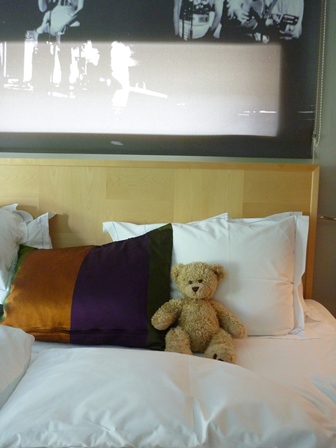
And teddy bears. There are teddy bears in every room. If there's a
connection between Abba and teddy bears, we still haven't figured that
one out. But he's
darned cute.
We had taken Taxi Stockholm
into the hotel (on the concierge's recommendation). The
experience was a little odd. Crowded multistory buildings with
water
everywhere. Multilayer traffic, tunnels under stuff, bridges over
stuff, lots of driving beside water. We started betting each other on
how many bridges - there were more then 6 bridges between the airport
and
the hotel - Neil won.
We wandered around Stockholm for a few hours (and almost 4 km)
before dinner - most of the small crafty tourist shops in the Old
Town
were open, even on Midsummer's
Eve, and there are tons of them. Lots of little restaurants and
shops were still open, including several stone
shops selling amber. Since they didn't have beads of the right
size and shape, Neil was able to resist. We saw an interesting
blacksmith shop (closed) and some fashion shops (some open, some
closed). Handefast: The
Viking
shop was interesting with some nice simple metalwork, books,
other stuff - kitsch and good stuff mixed. We found a nice little
chocolate shop. Lingonberry truffles in dark
chocolate - yummy.
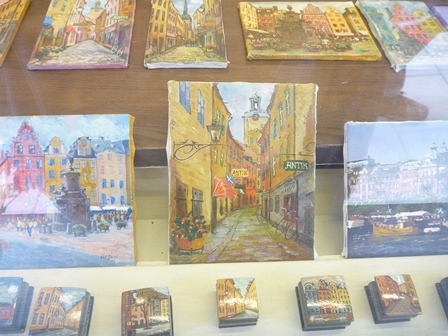 |
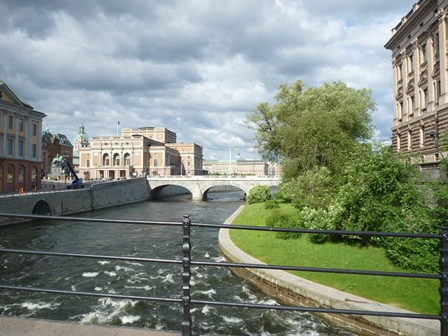 |
|
| This painting, in a store here, of old town captures it better Karen managed! |
Stockholm is a city spread over 14 different islands. This is just one of the waterways that separates it.
|
|
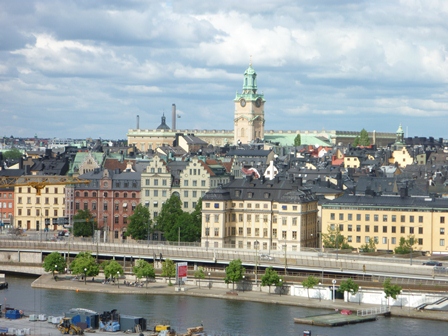 |
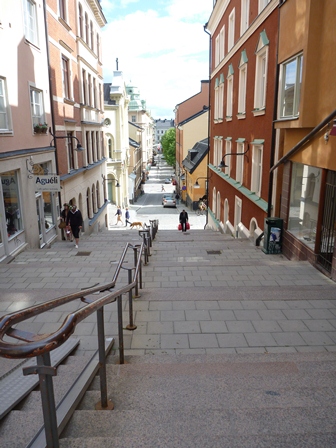 |
|
| Some parts are very industrialized, like most cities, and some parts are still old and beautiful. | A short walk down the street to the
hotel. |
Dinner at the Rival Bistro - a delicious shellfish casserole for both of us which is more of a soup than casserole. Karen had a lemon creme brulee with fruit, and Neil had a raspberry souffle with licorice sorbet.
Since almost everything (including the Historiska
Museet) is closed on Midsummers Day, we departed at 8:30 am for 8
hours in a mini-bus with Steinthor Olafsson, the overly talkative
driver on a Viking
Day Tour. Right off the top, we had this inkling of trouble when he
decided to use the 'new' definition of the Viking Age as 400 - 1300 AD
instead of the more traditional 793 - 1066 definition that we're used
to using. Apparently this means one can include a lot of gothic
churches in the tour. He also provided lots of data about the social
history, economics and royalty of Sweden which certainly filled the
drive.
To be fair, there was an awful lot of interesting things to see and he
had some interesting theories on the Viking Age to share, but the
fellow just wouldn't shut up long enough for interaction or reflection
or the chance to absorb through other means. Neil and Karen are both
readers and like the chance to read the signs at places too. We
stopped at the following places.
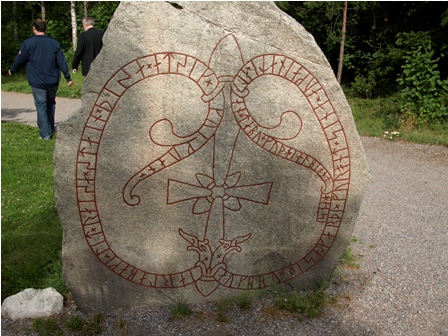 |
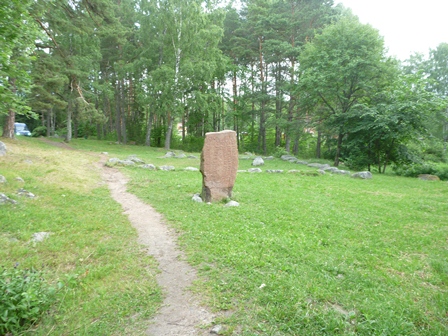 |
|
|
This is the runestone at Jarlabankes Bro which is an old viking bridge. There are two runestones and some other stones marking the bridge path. |
The next stop was Arkils Tingplats - a local thing site, with another runestone. | |
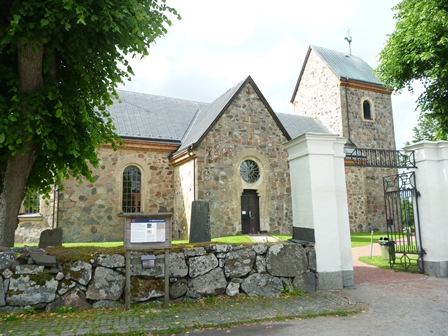 |
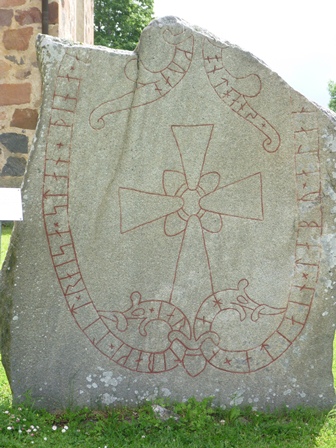 |
|
|
The church at Vallentuna. There is a runestone here as well as some runes cut into the church. |
The runestone at Vallentuna. |
|
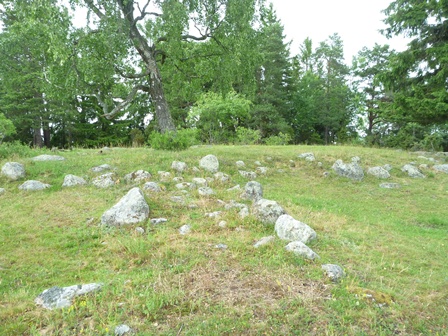 |
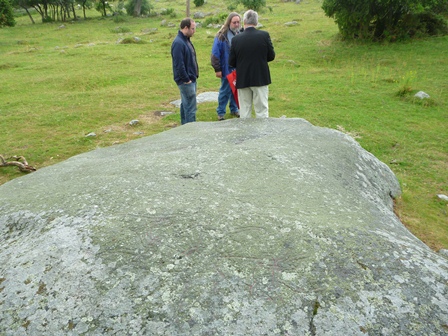 |
|
| A very interesting house and stone
site called Granby.
|
The runestone is a HUGE stone but it is lying down and the writing on it is very difficult to see because of the lichen overgrowth. |
|
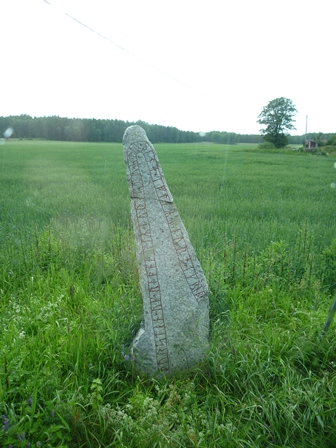 |
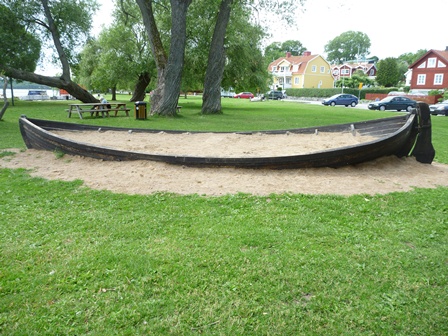 |
|
| We looked at the runestone at Lunda from the bus as there is no place to park. | In Sigtuna, where we stopped for lunch, we saw this interesting use of a faering. Some of the parents in our group of friends might enjoy the idea. It's a sandbox. |
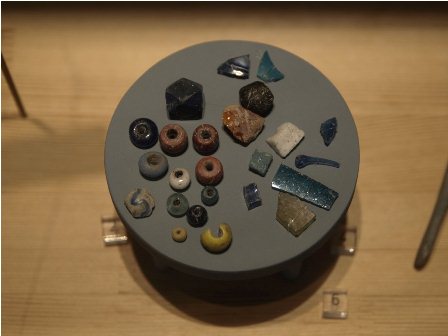 |
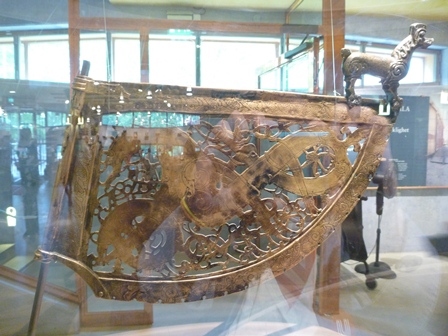 |
|
|
Beads and bead making supplies |
Norse decorative weather vane |
|
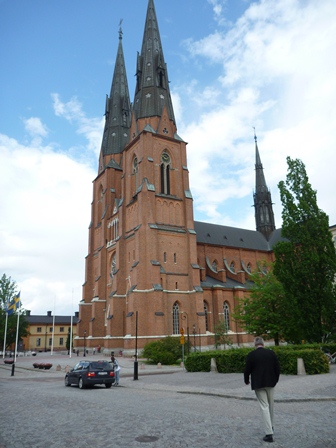 |
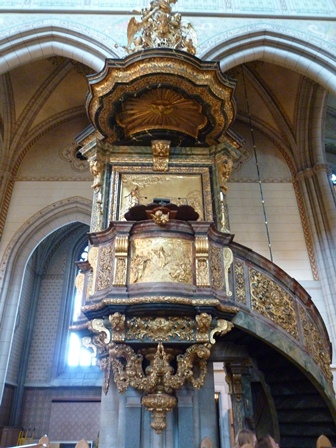 |
|
| On our last stop, we went into Uppsala to see the Uppsala Cathedral - construction began in 1287 so technically it fits into Steinthor's definition of the "Viking" age. | Both Gustav Vasa (one of Sweden's more prominent kings) and Carl Linneaus (famous botanist) are buried here. |
On the way home, Steinthor felt the need to fill the
silence with a rather through recitation of the line of the royalty of
Sweden - important features of each reign, who was gay and how they
managed heirs anyway, etc. He finally finished with someone in the
1940's, still about 10 minutes away from the hotel. Karen felt cheated
by not getting the list right up to date to the modern set of Royals.
On the recommendation of the concierge at the Hotel Rival, we had
dinner at Pontus by the Sea in old Stockholm. Here's a link to
the english
menu for Pontus by the Sea. It is a lovely restaurant, quite
literally on the sea-side in Stockholm. We watched boats come in,
people of all sorts walking by on the boardwalk, observed the weather
and skyline of the city.... and ate delicious food.
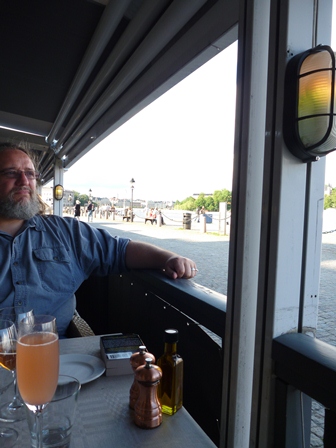 |
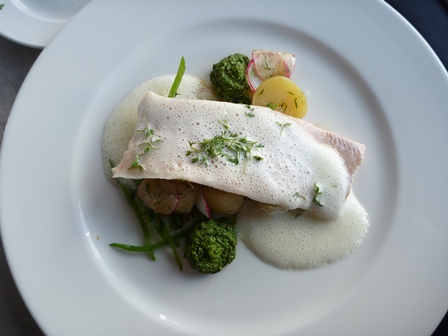 |
|
|
Here's Neil getting drifty with the scenery. |
Karen's food - char with lemon foam and dill pesto. | |
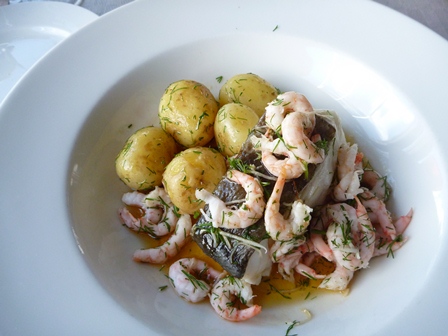 |
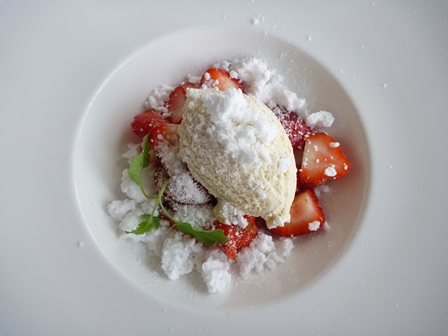 |
|
| Neil's choice - cod with shrimp and butter (again with the butter!). | And Karen's dessert - fresh strawberries are a big thing at Midsummers in Sweden. Neil had a creme brulee. |
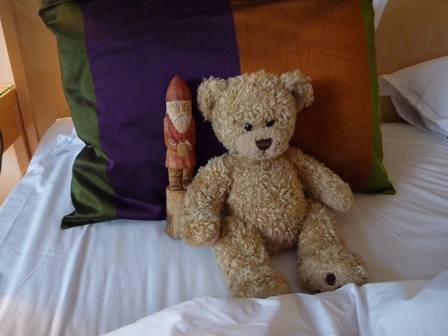
Snorri made a sad farewell to Teddy.
Sunday morning, after a nice late awakening and mellow breakfast, we
trundled off to Bromma airport to pick up our flight to Gotland.
There was a slight delay in that they cancelled our trip and moved us
to the next plane, an hour later. No big deal, we weren't in a rush.
This was our plane - getting in by climbing up the stairs is old school
now 'though - we did that on the last IcelandAir flight. But the
propellers were new for Karen. And the experience of flying an entire
trip in an airplane without understanding a word of the language was a
first for both of us as well. Good thing the safety demo was pretty
self-explanatory. :)
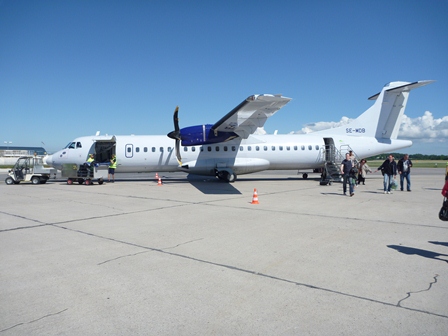 |
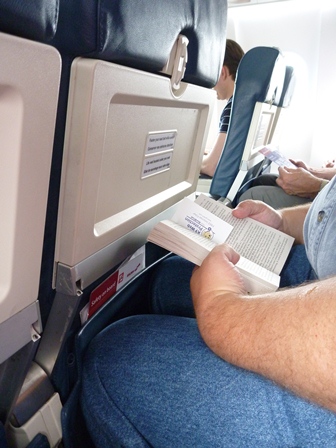 |
|
| Nice little plane. |
The legroom - not quite the same as we experienced with IcelandAir! |
It's a much much smaller plane with four seats per row. If
there had
been anyone in the seat in front of Neil, they would not have been able
to recline their seat.
We took a taxi to Hotel
Stenugnen then went for a walk about the Hanseatic Town of Visby
- a UNESCO world heritage site.
Visby is a delightful town to the senses - it really gives off a laid
back beach front slow moving relaxed vibe - at least in the summer, at
least inside the walls.
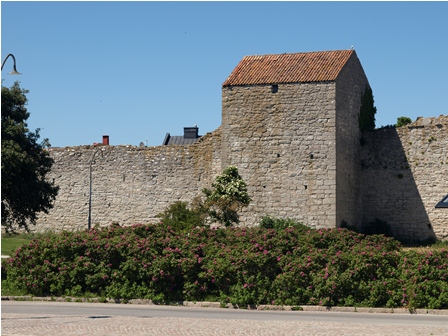 |
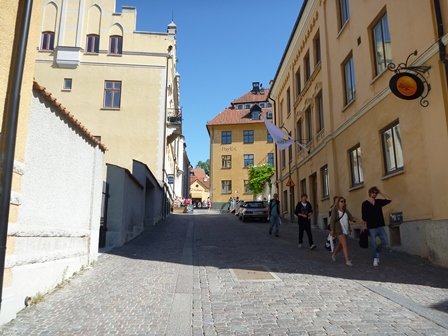 |
|
|
The town wall was likely begun in the 12th century. It was
rebuilt to it's current height in 1280, and finished sometime in the
beginning of the 14th century, although some towers were added in the
15th century. See the Wikipedia entry here for
more information. |
Cobblestone streets inside the wall, including stone gutters on the edges of the streets, and a rather obvious change in altitude from the shore to the wall make it an amusing walk. | |
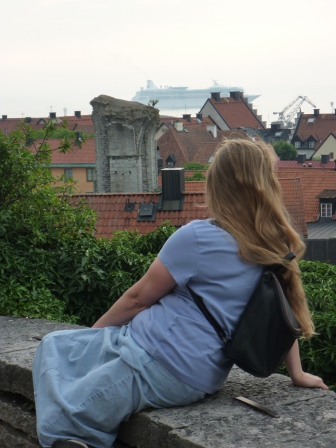 |
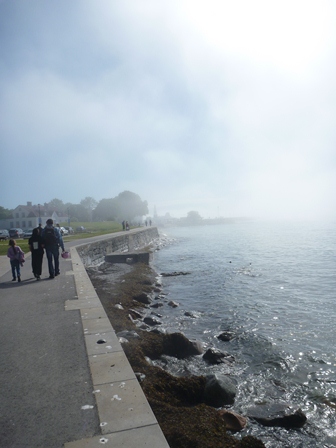 |
|
|
Karen looking down over the town. The ruined church and
cruise ship in the background add a nice touch. |
This is the laconic waterfront.... note the entire lack of a fence on the boardwalk. | |
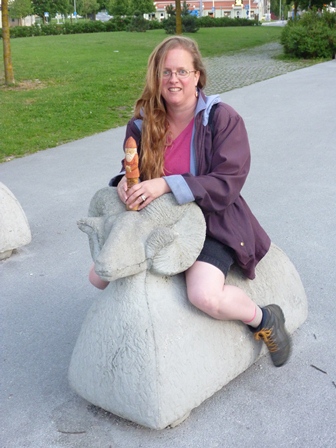 |
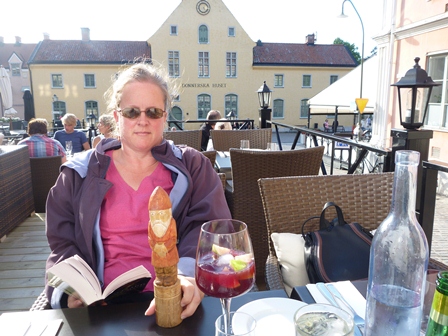 |
|
| The whole town has these interesting sculpture/seats scattered around - some are adult sheep and some are lambs. Snorri and Karen visited one of them. | Snorri and Karen were very very relaxed - She's got a sangria on the go, a blanket* on her lap, sunshine, a good book and Neil's company. What more does one need? |
Dinner was on another outdoor patio at Donner's Hotel Tapas Bar
- interesting flavours of shrimp. Salty fish, Paella, fun
dessert.
*Interesting note about blankets at restaurants - it's common to
many restaurants with outdoor patios in Sweden to provide blankets
should there be a chill. Karen thinks this is a very civilized
practice.
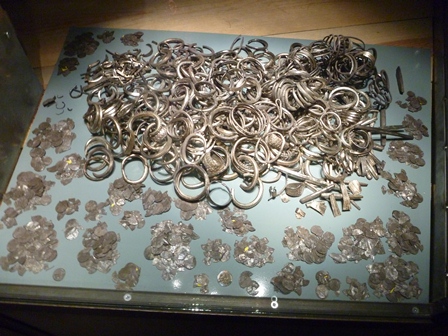 |
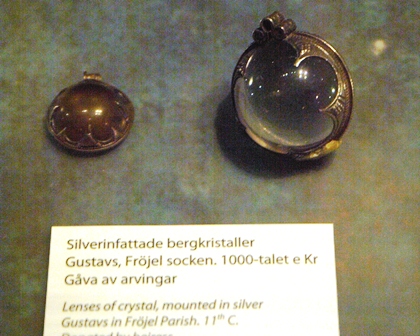 |
|
| Wow, some of
the silver hoards found on Gotland are BIG!
You can say 40 kg but until you see it it is just a number. |
As soon as Karen saw the crystal necklace, she immediately coveted one of the big round lens. | |
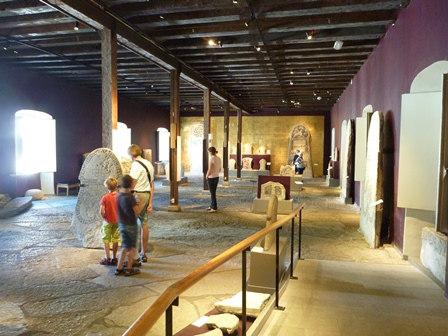 |
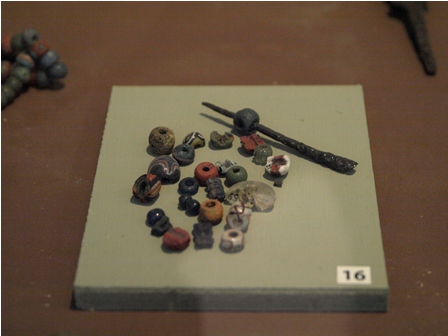 |
|
| The focal room of the museum, with lots of carved rune stones. | Beads and material from Paviken |
They
also have a new exhibit on the 1361 battle of Visby. Neil has
known about this battle/grave for years, used it as research on armour,
and yet it wasn't until he was standing in the exhibit that the pieces
connected. Overall, this museum is well worth the effort of a
visit.
Just before we left Visby, Karen walked over to the music store that
she had carefully looked up on the Internet. The location was an easy
walk, just outside of the medieval wall. Karen had wanted to rent a
guitar while she was here, so that she would be able to stay in
practice and keep her calluses. She had corresponded with the store
ahead of time by email, and they suggested that it might be cheaper
just to buy a guitar rather then rent. She had hoped to finish that
conversation with them - the problem is still the same - can't take a
guitar back on the plane. Unfortunately, the store was closed for the
Midsummers' holiday.
In the afternoon we got on a bus and headed to Fårösund (pronounced
FOR-ur-sooned), at the top of
the
island. Our field school residence here is a wee bit of a walk from the
bus stop, especially with heavy suitcases and an uncertain sense of
destination - directions to the residence were sparse in the
information package that the school sent out. Karen was very very
thankful to find that the first people we ran into
were from Toronto! Alanna and Andurs and her mom, Kim. Alanna and
Kim are from Scarborough, although Alanna and Andurs now live in
Stockholm
and are regulars on the dig crew. Kim was, like us, on her first
trip. They pointed us in the right direction and we quickly settled in.
It's a
nice room with lots of space, and a small kitchenette. Karen briefly
mentioned on Facebook that there was only one internet connection in
the room (we had both brought laptops) and quickly got told off by
one of her older archaeologist friends who ran on about his first field
school on the side of a mountain, in tents, and how cold it was, and
how they had to take turns cooking, and could only do the laundry once
a week when they could get to town....... She shut up quickly with
mentioning any hardship after that!
School started on Tuesday morning because of the Midsummers holiday. Our morning was filled with introductory information.
The vice-principal of the school welcomed the group, in Swedish, and gave us some information on the school's facilities and staff. Dr. Carlsson translated the highlights for us english speakers after she left.
Alanna, who is doing her Masters in Anthropology at the University of Stockholm, introduced the anthropological study she had planned for the duration of the dig.
Dr. Dan Carlsson recapped some important points from the manual,
greeted new and old faces, and explained his reasoning for searching
for a Viking era harbour town in Slite (pronounced Sleet-ah). It is not
bad reasoning, but rather slim. A combination of knowing that
there MUST be more harbours than have been found; a nearby viking era
grave field (excavated in the 1950s), a note on a old maps
(16th,17th,and 18th century) maps identifying interesting place names
(such as Barlastplats [ballast place]) and Gamla Hamn [old harbour];
combined with currently understood changes in elevation [about 2m rise
since the viking era]; and a review of maps to determine places where
there has likely been no construction. Dan had gotten permission
from a bunch of landowners to dig in their yards (and no permission
from others) which controlled exactly where we went looking.
There are 24 people in the school - 6 of us are here for 4 weeks, and
the rest for 2 or 3 weeks. There will be a second group of 2 week
students that arrive mid-way through the 4 weeks that we are here.
Because we are digging in people's back yards throughout a town, Dan
divided us into small groups. All of the 4-week people are grouped
together and stayed together throughout the school. Konrad was assigned
to be our trench leader.
At the dig site we expected a lecture on about how to remove turf, how
to remove ground; how to sieve. Nope, have a shovel, have a
bucket.... off you go. The advantage to this method is that the 6
diggers assigned to our trench have 24 years experience digging
(averaging 6 years year not counting Karen and Neil). That means
we have a lot of experience to draw on, but it isn't presented
formally. The school provides trowels and other digging supplies, but
we had brought our own trowels - a Marshaltown
and a WHS
trowel. Apparently there are strong advocates for both brands and we
wanted to compare and contrast the tools throughout. By the end of the
dig, Neil and Karen had come to the conclusion that it's all a matter
of what you get used to using. Neither better had any feature that
stood out and made it better then the other. Moreover, we encountered
at least one incident in which one of the staff archaeologists borrowed
our tools to use when we were asking them about a spot in our trench
and then traded it in for one of their own - a tool they were used to
using!
Of the 6 people in the trench, 5 are avocational (including one
anthropologist) - Neil is the only school trained archaeologist.
But they have WAY more experience. Then we have Astrid (staff -
osteology), Anna (staff - generalist), and Dan (lead archaeologist)
wandering around, commenting on finds and poking away at various
aspects of the trenches.
We addressed the lack of a formal program by asking lots of questions,
and prompting english reruns of any trench related conversations that
drifted into swedish. The field school is officially taught in english,
but the Swedes outnumber english dependent speakers significantly and
sometimes the conversation happens in the language more familiar to
them.
As an example - Neil wondered why trench 1 was a 2m x3m trench
rather than long/slim (say 0.5x12m). He asked for enlightenment.
It turns out that we aren't expecting graves at this spot and a broader
area gives us a better chance to identify other features. In the
next spot that we would dig (trench 7), graves are more likely so it
will be long and thin to better optimize our chances of finding
something significant.
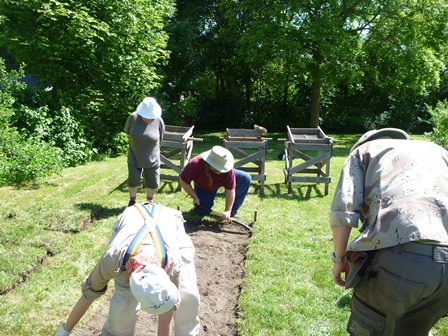 |
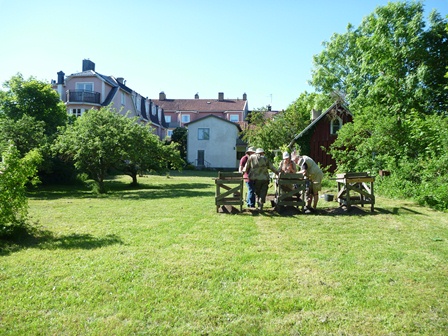 |
|
| We are digging in the middle of a small town, in people's back yards, so..... we give you turf lifting the old fashioned way! | This is the backyard of the house
that we can
dig in. Some homeowners
were enthusiastic about the project and some put limitations on where
and how long we can be there. This homeowner is very enthusiastic and
apparently has said 'dig it all up!' |
|
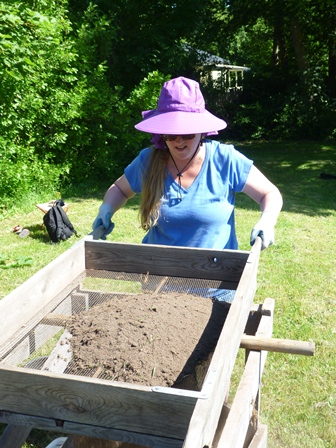 |
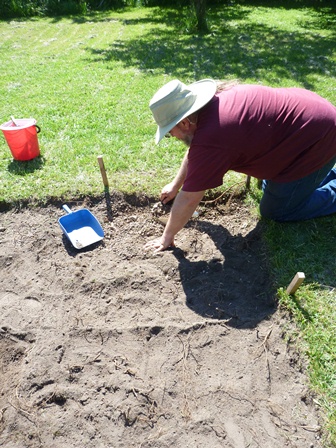 |
|
| This is Karen sieving her first bucket of dirt. | We are each responsible for a 1 metre by 1 metre square. |
Neil was responsible for Square [Ruta] 2/0 of GO 2011 Othem;
Mäsen 17; Trench [Schakt] 1. Mäsen 17 is the street address of the
house that we are in. Othem is the parish that Slite is located in. GO
2011 is Gotland 2011. We dug in layers that are approximately 10cm each
- this varied according to what we found as we moved through the depth.
Karen was responsible for Square [Ruta] 2/1 of GO 2011 Othem; Mäsen
17, Trench [Schakt] 1. Square numbers are assigned from the south-west
corner of the trench - 0/0. Karen's square was in the north-east corner
of the trench.
Layer [Lager] 1 was 10 cm of sod and plow zone mostly hard packed clay
based soil with the western most 30 cm in pea gravel. Sieving pea
gravel sucks since all of the gravel is caught on the sieve and it
takes forever to look through it all. (sieving sand on the other
hand is awesome - see layer 4/5).
This is Karen's first box of finds, in the first layer of the trench.
For those not familiar with archaeology, that's the fairly modern
stuff. You can see pottery shards (porcelain, glazed, and unglazed but
shaped), burnt clay, flint shards (all of which is imported into
Gotland), chert shards, some glass bits, two iron nails, and animal
bones (fish, bird, pig). Dan offered a bottle of champagne to the first
person to find a Viking Age coin.
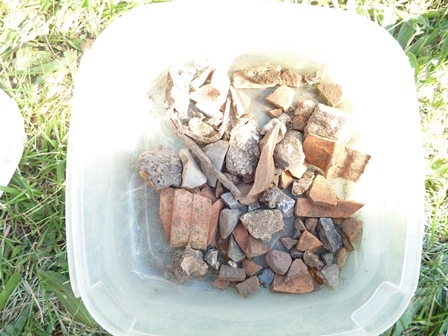
And for the gastronomically inclined, this is tonight's dinner. We're
eating as a group on a meal plan, at a nearby student hostel. Buffet
style, limited choices each night. Tonight we had some sort of fish in
some sort of sauce and chicken in some sort of gravy with vegetables
and baked potatoes. Both lunch and dinner are very...... culturally
specific. Lots of potatoes, rarely spiced, and quite a few white
sauces. Breads are generally preferred hard and crispy, although softer
breads are not uncommon. A meal without a baked potato was extremely
rare.
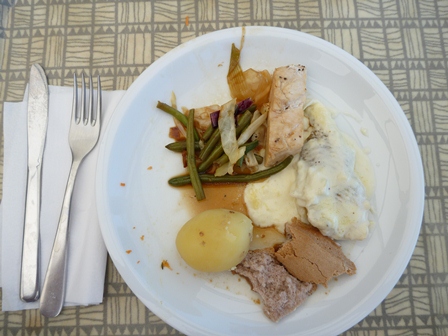
.
We continued the work defined above. Nothing too new today although Karen did get to remove her box.
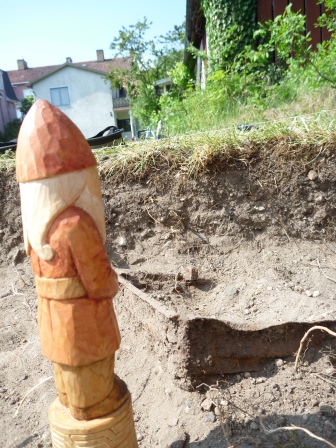 |
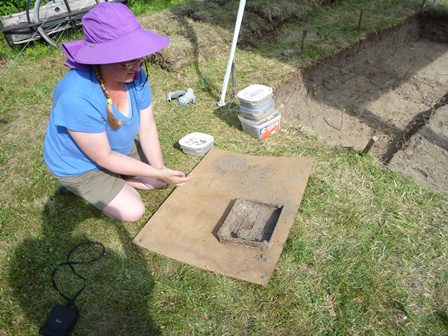 |
|
| Here's Snorri trying to puzzle it out while still in the ground. | And Karen with her prize after it
finally got
dug out. It was
visible in
layer 2 but Karen had to finish evening out the layer and leave it
until we
could get to layer 3. It was somewhat frustrating walking away from it!
It clearly isn't Viking Age, but it was the biggest find yet! |
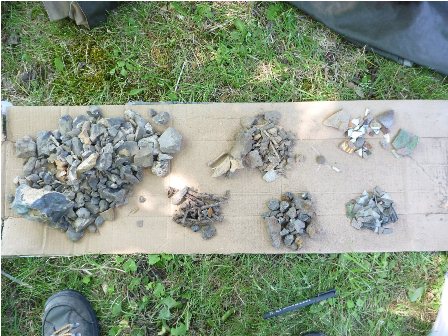 |
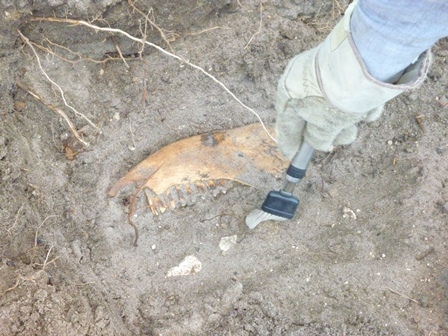 |
|
| Just to help with an impression of the types of finds here are the cleaned finds from layer 3. From left to right - flint, iron, bones, slag, ceramic and glass. In the middle between the bones and ceramic are two small objects - a clay pipe, and a button. | Konrad's square was also interesting in layer 4. It had the right side of a cow's mandible and teeth, and some big stones in the bottom of the trench that may or may not be part of a construction, although they think it unlikely for a variety of reasons. |
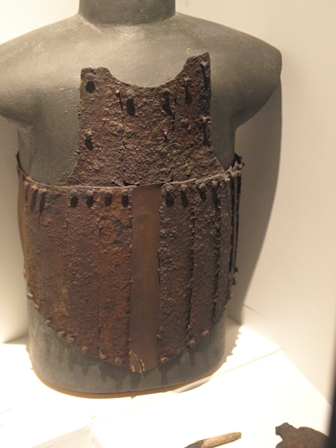 |
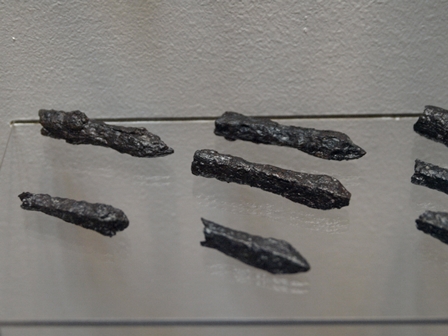 |
|
| Coat of plates from the 1361 exhibit |
Projectile points from the 1361
exhibit |
|
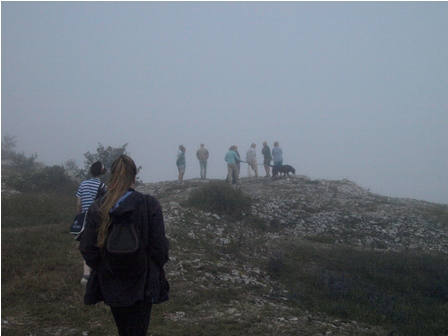 |
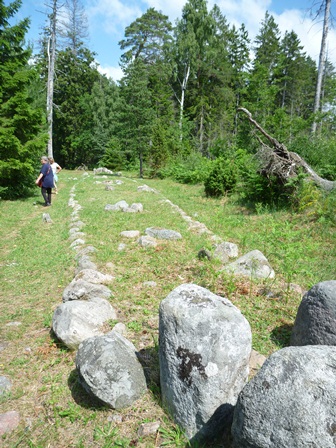 |
|
| The second stop was Högklint which is supposed to have an awesome view - unfortunately the view was completely fogged out. | We moved on
to a sequence of late bronze age stone ships
starting with
Smagarde. According to Dan the stone ships are sometimes
cremation
graves
(usually 1 per
boat). |
|
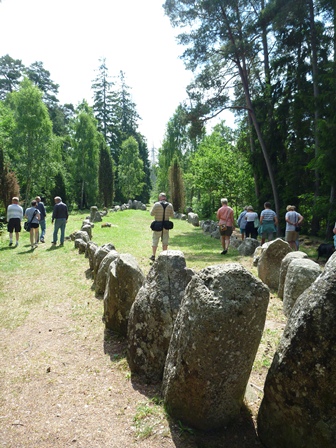 |
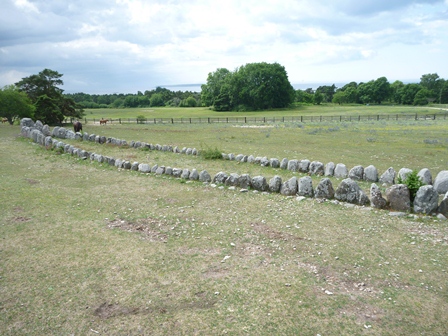 |
|
| Next was Gnisvard. | And finally Gannarve. There are over
750
identified stone ships on
the island and very few have been dug. |
|
 |
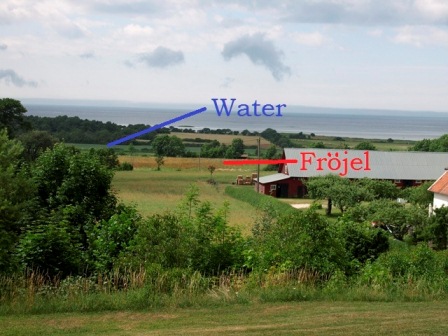 |
|
| Lunch was a stop at the fishing village of Gnisvard to eat the lunches we had packed in. | The next stop was Fröjel.
The dark green strip in the photo would have been water (strait) with
the trees further out as an island. The green/brown field is the
site - 100,000 m2. Only 1.5%
of the area was excavated, revealing 40,000 objects. There is no
plan to
excavate more as they don't feel that it will add more to the story as
they know it. |
|
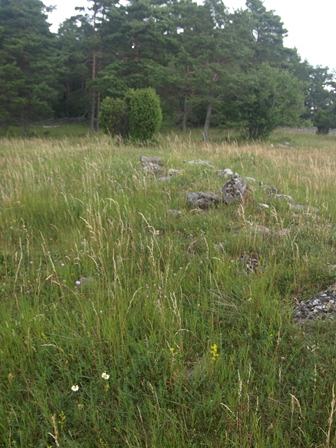 |
 |
|
| Next stop was the Vallhagar
Iron Age
settlement - a large number of
iron age house ruins. In walking among them, we had a good
discussion of how to read the landscape. What? You can't see the
wall of
the house there on the right of the image? |
The next stop was at the picture stone at Ange farm - the picture there is pretty much gone. We spent time trying to puzzle it out. | |
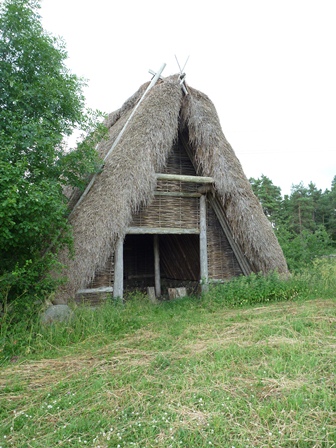 |
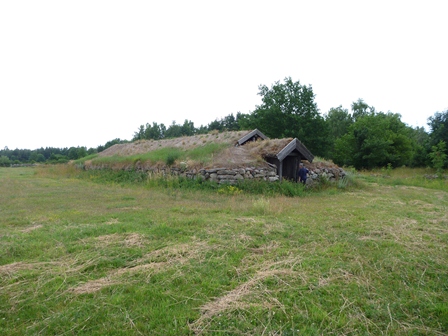 |
|
| This was followed by Gervide which has two Iron Age reconstructed houses. | The second house at Gervide.
This one had a lower pitched roof since it was made with sod, not straw. |
|
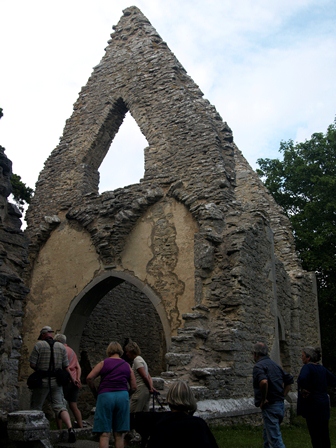 |
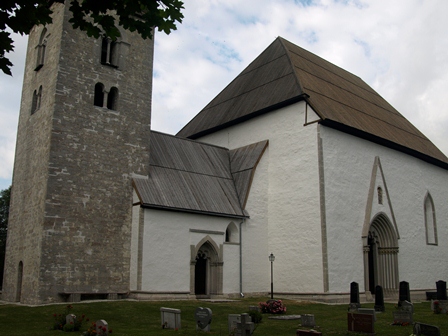 |
|
| The second last stop on the way home was the Bara parish deserted church. It was deserted in the 1600s due to economic decline. At that time 3 or 4 parish churches were being supported by only 4-6 farms each and could not be maintained. Parishes were consolidated. | This church ran out of money during
reconstruction. The tiny little part should have been MUCH bigger. |
Karen opted to make Mac and cheese in the room rather then go out
with the group to dinner. She needed some down-time for her introvert
side.
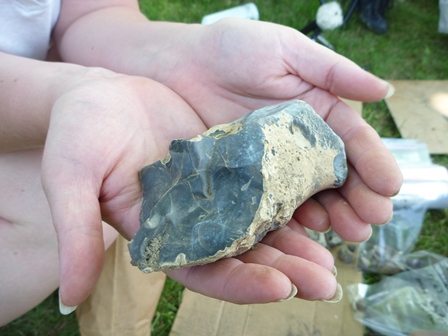 |
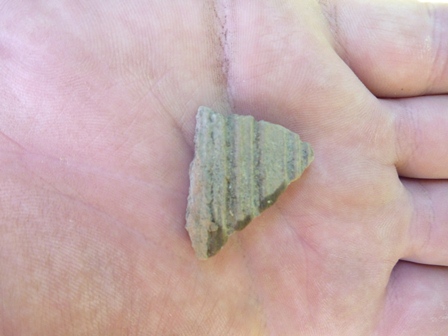 |
|
| This is possibly the single largest piece of flint that we dug up - weighing in at 320g all by itself, and it's only one piece. | One piece of ceramic Neil found while sieving Karen's square might be Viking Age. Maybe. But the square is so mixed up, it really doesn't mean anything. |
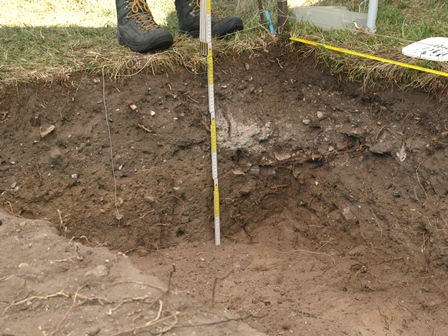 |
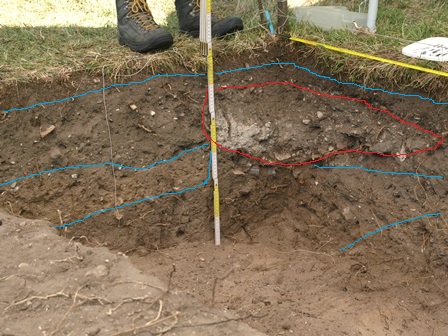 |
|
| In this profile shot of Karen's
corner the
midden is visible coming up
to the right and sort of hiding behind the metre stick on the
left. The large white patch by the stick is near the bottom of
it. You can likely make out some glass in the walls. The
three different layer colours are fairly visible on the left. |
A little creative editing to help
people
visualize |
|
 |
||
| For those who think more pictorially here is the official profile. | ||
A new trench designated trench 7 was laid out 17 m long on an east-west axis by 0.5 m on a north south axis. This trench was located to the north of trench 1 in the same yard and was close (100m) to where three Viking graves had been previously found. The east-west alignment of the trench was to increase the probability of intersecting graves which are traditionally aligned north-south during the Viking age in Gotland. The plan was to open a total of 6 m of the trench, 2 m at each of three spots.
We opened the first 2 m, dug it down to sterile sand at 50 cm through pretty much exactly the same lack of stratigraphy as trench 1 with very similar finds to those from trench 1 but with almost no flint. It was determined that a profile of this trench would not advance the excavation goals so it was backfilled and closed. The next day we opened the remaining 4m of the plan.
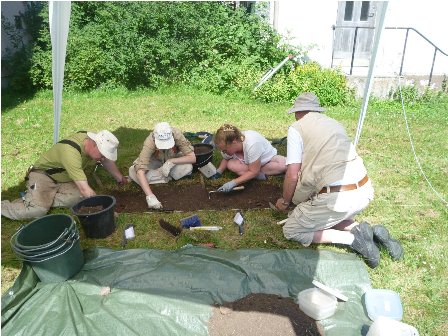 |
| Left to right: Andurs, Alanna, Karen and Konrad. Konrad bought the shade tent for us - a wise and caring trench master. |
Today we finished the remaining 4 squares. The eastern two squares were in line with a gate in the fence and an old drive shed in the yard. Karen, Neil and Konrad handled these 2 squares while Andurs and Alanna started on the western two squares. Immediately under the sod was 3 cm of crushed limestone - likely a driveway given the alignment of a gate with the house. That material proved difficult to dig through. Interestingly the limestone covered everything except a 40cm band approximately 40 cm from the eastern edge.
Below this was the soil column we were familiar with containing the usual assortment of finds. A little further down we hit a very compacted clay - mostly in the eastern meter but some spots in the western meter as well. It was also missing the same 40cm strip noted in the limestone layer.
Immediately below the clay was a very thin black layer. We called
in a staff member to examine it before we dug through it and down
through sterile sand to 50 cm. We then drove two test points down to
around 80cm to ensure it was sterile.
The determination
on the eastern section is that we had two driveways, one modern (the
crushed limestone) and one older (the clay). The 40cm gap in the
driveways was likely either a slot opened for a pipe, or the driveway
was built as two tracks rather than a solid surface. There is a water
well south and a little east of where we were digging so a pipe is
possible, but we did not find it. As there was nothing exciting or
specifically Viking-era the eastern section was closed.
In the western section, Andurs and Alanna had worked down through the
familiar soil column finding the usual finds. In the eastern part more
of the clay layer was uncovered. They had a lot of rocks in this
section, so they were slower going. Neil, Konrad and Karen joined them
to finish off this section.
The fact that we found a hardened clay layer in three of the four trenches we did in that yard at approximately the same depth never did get a good explanation. Since it was clearly not dated to the Viking era it was not of primary importance to our excavation.
We continued to work on the western part of the section taking it down to 50cm while we waited for the staff to arrive to examine the clay on the eastern side. At 50cm depth the western end had a demarcation between the sand that filled the rest of the trenches and a brown earth. Even odder was that the demarcation matched the slightly north-east alignment that had been seen in a possible grave being investigated in trench 6 by another team.
It was decided to open an additional meter on the northern edge of the western meter. We found masses of rocks mixed with gravel and brown soil all the way down to 50cm. It was distinctly different from any other soil column we had worked with. Neither we nor the staff archaeologists could make anything looking like a habitation layer out of it. We did find a bit of modern porcelain in the brown earth in the eastern square at 50cm depth and some modern blue glass at the bottom of the original western square. We decided that it was likely that we had a mixed/backfill situation.
Since we failed to identify a Viking layer, or any graves we closed
the remaining trench and marked that yard as completed.
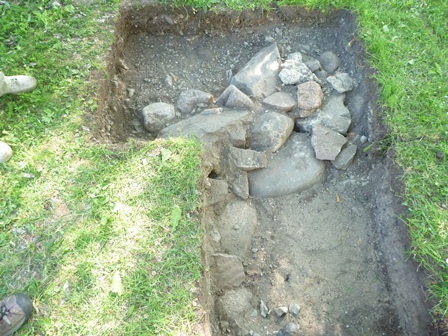 |
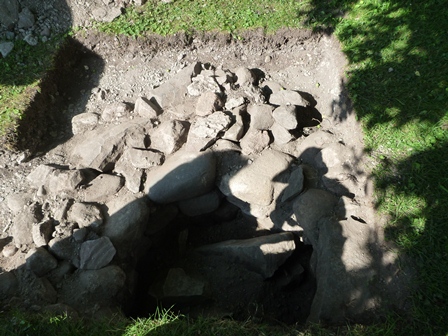 |
|
| At some point this week, we had a
bit of
excitement in one of the other
group's trenches. Trench 6 produced what many speculated might be a
possible Viking grave. |
But by the end of the week, we knew
it to be a
well, and the lead
archaeologist thinks it belongs to the 18th century at the earliest. So
crushing... |
Overall the group opened a scattering of about 38 m2
in
various folks yards. There were interesting finds like a 16th
century
coin, and an 18th century Danish coin. Since neither of these
coins were Viking Age, there was no champagne awarded. Where we found a
lot of
flint and a little slag, others found a lot of slag and very little
flint. Ceramics were everywhere but we had the only very early
piece. Like our trenches the other trenches seemed to have little
in the way of stratigraphy. Overall that makes it unlikely that a
viking harbour was in the area we surveyed. Not impossible, just
unlikely. There are many other spots in that town that could host
a viking harbour town but we didn't have consent to dig those areas,
nor had a previous construction review been done. Further
investigation will need to await another year. For those
interested in this possible location the concept is discussed in The
Spillings hoard - Gotland's Role in the Viking Age World Trade,
Ann-Marie Pettersson ed., Gotland Museum, Visby ISBN 978-91-88036-71-1,
beginning on page 93.
Wednesday night's lecture by Johan Norderäng and Margreta Christon was
about the excavations in
Västergarn,
which was really quite interesting. It's really close to, and
historically related to another place called Paviken, which has some
evidence for bead-making so needless to say, Neil listened
closely. The speakers were the organizers of the University of
Gotland field school at
Västergarn. To provide background, Paviken was dug from 1967 to
1973 by Per Lundström and was a bit north of Västergarn but on a lake
fed by a
river passing in front of Västergarn. They found 210 kg of animal
bone, 20 kg of slag, 2 kg of pottery, 2400 rivets, that thousands of
other finds. They excavated 1000 m2 of a site believed
to be 15000 m2. C14 dating of some
uncertain samples gives a date range of 915-1075 AD
although Per apparently just used 995. A grave provided bone for
dating with a range of 940±85 AD.
Apparently the river silted up and Paviken shut down around 1000 or
1100.
Västergarn seems to have been created around the same time and
had a large stone wall in a similar shape
of Hedeby and Birka. The wall was apparently built around 995 and
is 1
km long, 15 m thick, and 3 m high and built using viking, not medieval
techniques. Previous digs confirmed medieval habitation but didn't turn
up viking era artefacts. The assumption was that the place was
empty
before the first church was built in 1150. The field school for
the last 6 years has been focused on locating viking era finds.
From
2006 to 2011 the school has dug 775.55 m2
obtaining 650.2 kg of bone, 447.6 kg of slag (iron and glass), 54.5 kg
of pottery and more than 1600 rivets including many viking era objects.
Since our group had finished up our trenches on Wednesday, we all went
out to Burs, in southern Gotland, for a new adventure on Thursday while
the other groups finished and closed their trenches.
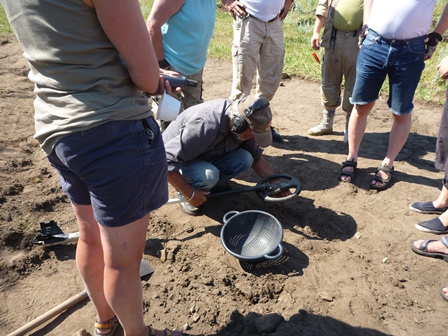 |
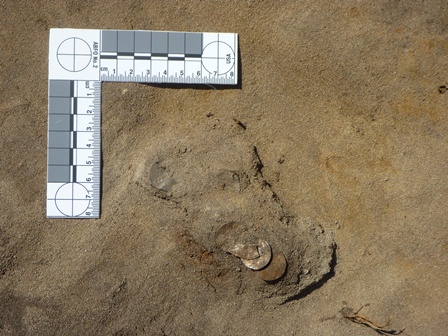 |
|
| Metal detecting a coin |
We did find the original point
source of the
hoard. We saw 7
coins on it. |
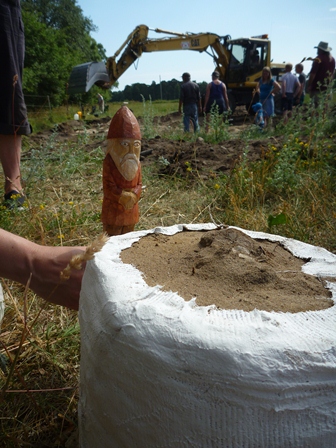 |
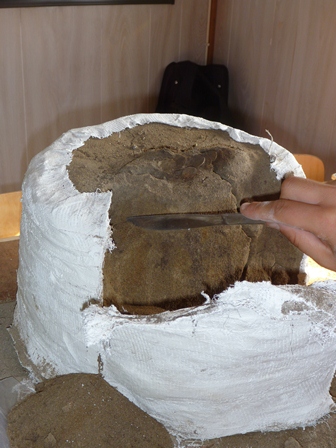 |
|
| Snorri thinks it's his birthday! | The rest was excavated in more controlled conditions Friday morning. |
We left the place a big mess. But we did find a silver
hoard! In total there were 70 coins and two small
pieces of jewelry. And before you ask, they don't like to put monetary
values on silver hoards - it's simply too tempting for thieves to steal
the cultural treasures of the island with their own metal detectors. A
small group of people were recently arrested and prosecuted for such a
crime.
Karen wasn't quite as impressed with the day as Neil was - for her,
it felt more like treasure hunting then archaeology, and she was bored.
There 20 odd people following Dan around with his metal detector and
taking turns pulling the coin up from where he pointed, and trying to
find a place in the increasingly diminishing shade to wait out the
boredom. She recognizes that the excess of people would have been
necessary if we'd found any evidence of habitation, and that 'rescue
archaeology' is important, but she spent the day being bored and
scorched by the sun - not fun.
This morning was a trip to a possible location for next year's field
school - File (pronounced feel-uh). File was a farm through
recent historical times but is now abandoned. Nearby is Litla File
which was abandoned in the 1500s.
We did a field walk trying to locate traces of Litla File.
We located several tentative stone buildings. We also looked at
contours and possible field use patterns, which was something
interesting to learn. The next step (better done in spring) will
be to come back with a GPS, Total station, theodolite combination to
map out the possible buildings and compare them to 16th, 17th, and 18th
century maps. Phosphate mapping would also be helpful in
choosing target
areas.
A theodolite is a piece of surveyor's equipment that provides accurate
elevation measurements and can also be used to triangulate positions.
A Total station is like a GPS on steroids. You set up a base
station, then carry a stick around with you. You put the stick on
something interesting (say a rock in a wall) and press the
button. The total station records the position. Repeat for
other rocks in the wall. Total station stores everything then spits it
out as a database file used for mapping software which prints you out a
very accurate map of your site.
Phosphate mapping is the process of taking a grid of soil samples from
various depths across an area of interest. Humans and animals
tend to produce phosphates in a number of ways which means that
occupation areas, burials, food-processing areas, latrine areas and
animal compounds and droveways tend to show higher phosphate
levels. Doing a survey can suggest places to dig.
Ground penetrating radar (GPR) is useless here due to the very thin
soil over limestone bedrock, and magnetometry doesn't seem to be common
here.

We did find this interesting stone feature. It went into the
trees in the distance. Perhaps a road?
Two of our teammates plus our osteologist had been pulled away to do
rescue work on a pipe laying site that had hit stone age burials - we
got their report at lunch. They excavated 8 skeletons in 4
graves. Grave 1 was an 18-20 year old male with a 6-7 year old
child. Grave 2 was a woman with a VERY newborn placed between her
legs, and was buried holding the legs of a man. This burial had a
bunch of grave goods - 2 stone axes, a javelin and a fishing
hook. Grave 3 was a single burial. Grave 4 was a single body,
apparently also with a young child. Dating for these graves was
around 5000 BP. The rescue work here was quite intense on the
time line with the backhoes having a "must start again" time and
date. Apparently the last skeleton was uncovered just 3 hours
before they moved in. Recovery instructions given: grab the
bones, grab ceramics with decoration (ignore undecorated ceramics),
grab any other artefacts and get out of the way of the machinery. This
was a very hectic three days for the team.
Today was our first real day off!
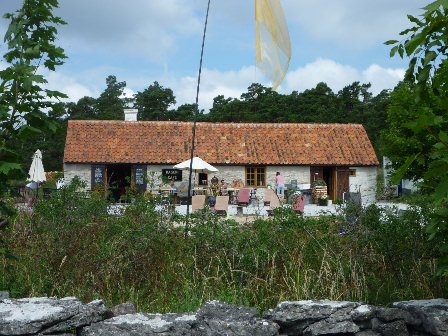
We started with a quick stop at
the bakery down the road which we had heard so many good things
about. Their cardamom buns were wonderful.
We drove down the west coast to
Hemse to the hand spinners
guild. Then over to Ronehamn to see Eko
Yarns. Karen made acquisitions in both places. :)
Then we drove up the west coast - while we found the town of Paviken,
we weren't sure where the dig had happened and couldn't see the wall
around the town that was mentioned. Mind you, we didn't look any harder
then out the windows as we drove by.
We had no trouble finding Vikingabyn
in Tofta - wow. They try to present history to kids and get bonus
points from Neil for letting kids throw axes, fire bows, carve wood,
make 'viking bread' on the fire, and.... hit each other with pillows
while balancing on a beam. The historical accuracy here is pretty light
weight. Costumes aren't the best. Many of the things
available for sale in the booths (not the gift shop) are clearly there
just to fleece the tourists who don't know any better such as the
sheela-na-gig figure or pentagram necklaces.
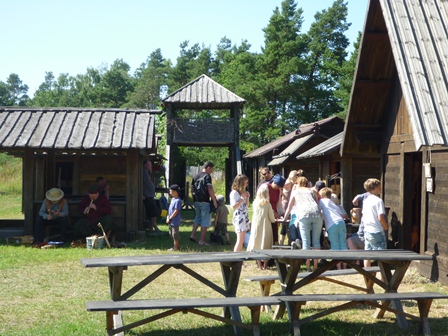 |
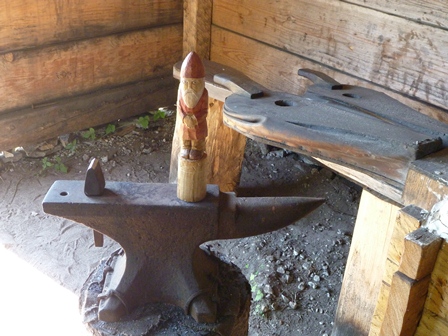 |
|
| This first shot is looking back past the merchants to the entrance. | One of the many problems with the
site.
This anvil is no older then the 18th century. |
|
 |
||
| Here are the skills area. Pillow fight on the log on the left, then axe, and bow as you move right. | ||
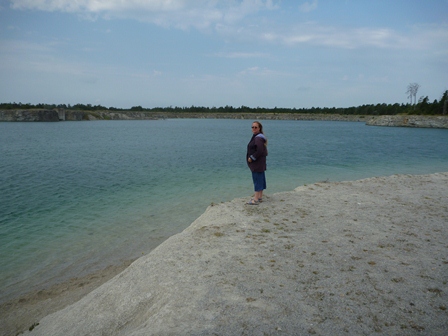 |
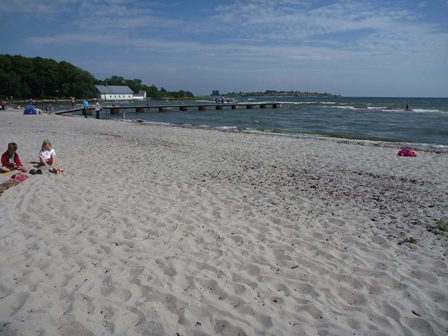 |
|
| Welcome
to the Blue Lagoon - not
quite the same
as the one in Iceland. This one is an old limestone quarry -
rocky, cold water, and windy. We skipped taking a dip in it although
apparently it is a popular swimming place. |
We went back to Slite for lunch at the thai and hamburger place and spent some time on the beach and played in the baltic ocean - neither of us had ever been in the baltic before. | |
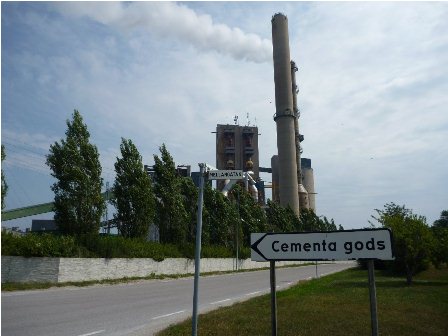 |
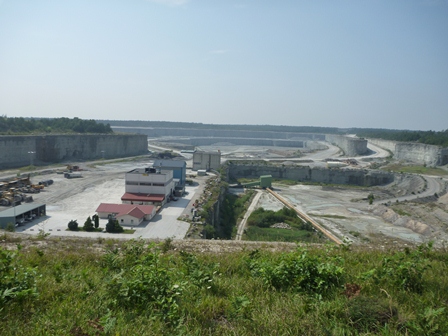 |
|
| We also stopped to look at Slite's cement plant which comes with an amusing sign. | People claimed this was last year's
trench, but I think it belongs to the cementa gods. |
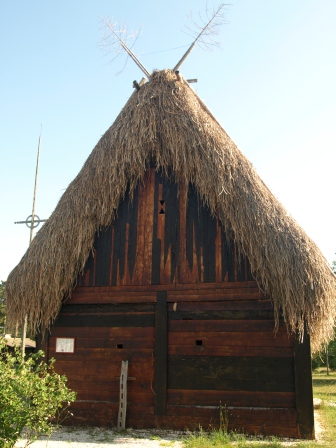 |
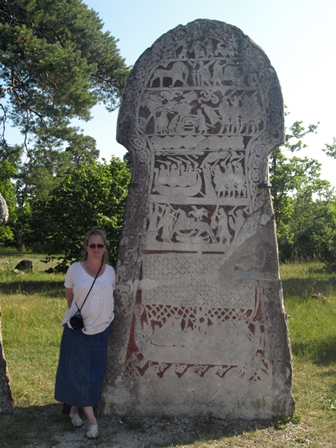 |
|
| Reconstructed house |
Karen and one of the local picture stones |
We began the new week with a lecture to welcome the new diggers
joining us for the last two weeks, review the status of the work in
Slite, and the plan for Hellvi, the next site that we would dig.
Our particular work at Hellvi was to be an Iron Age house (RAÄ 44:1).
It's a 600m walk from the parking lot, through both cow and sheep
fields and we climb over two fences and one bridge. We did this twice a
day, going both in and out for lunch back in Slite. We really got some
exercise in!
So why Hellvi?
In April 2011, a bronze mask was turned in to the museum by the heirs of a recently deceased person. Since the original finder is now deceased, there is little information on the exact location of the find other then in this Iron Age (in Gotland - 500BC to 800AD) house near the church at Hellvi. Museum staff have tentatively identified it as a bronze roman gladiators mask (or ceremonial mask for an auxiliary legion) from c. 150 AD that was used in ceremonial parades.
 |
| Picture is from the article in Aardvarchaeology. |
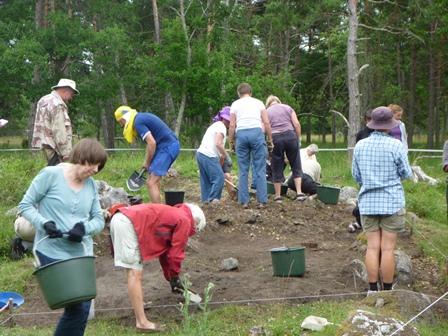 |
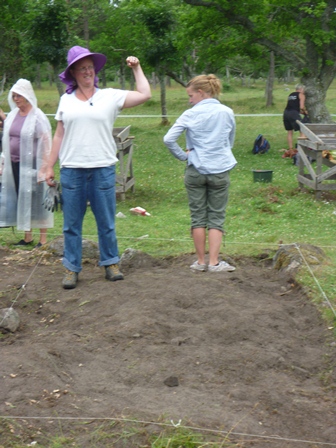 |
|
| De-turfing in full swing |
Here is Karen getting ready to attack our trench |

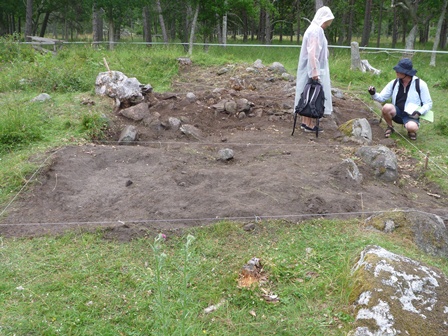 |
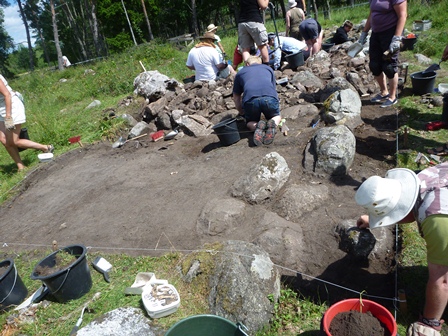 |
|
| After de-turfing but before much
digging |
After the first level was
removed. Notice
the wall is more obvious. |
|
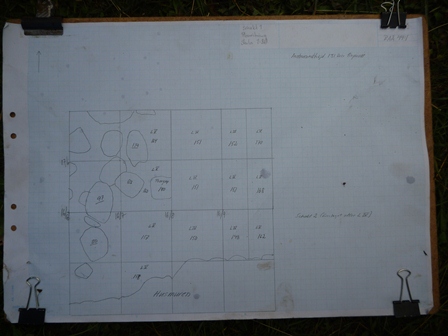 |
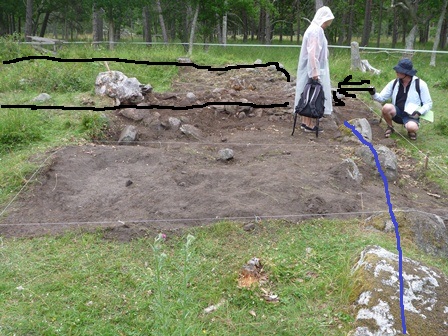 |
|
| The final trench drawing showing the
wall and
square elevations. |
For those who can't quite make out
the
house. We have drawn black
lines on the walls, and a black arrow pointing to an entrance.
The blue line is the outside wall that we are still puzzling over. |
|
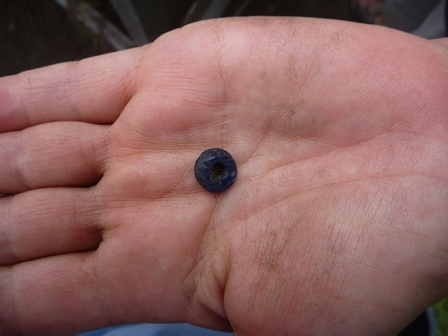 |
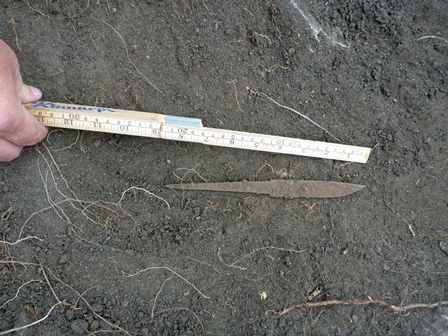 |
|
| One of the other trench groups found a blue bead in the house (Callmer type A172 for those interested) | And another group found a knife (likely migration period 350-450 AD) just outside the building in the fallen wall. |
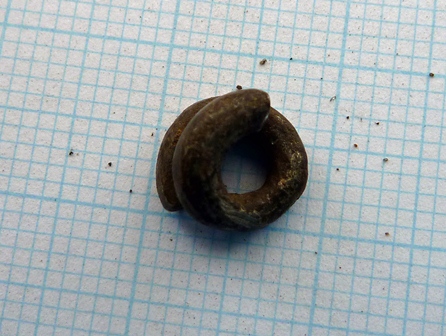 |
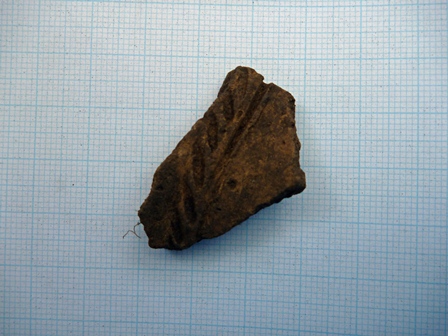 |
|
| A small silver coil from 17/9. Neil found this in the sieve. | A piece of migration era pottery found in the wall. Karen found it in the sieve. |
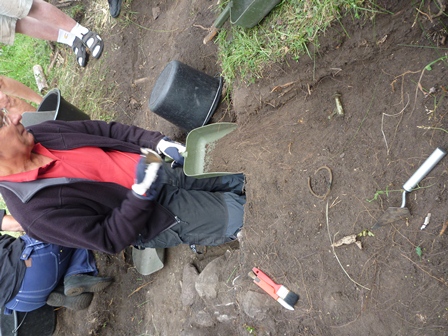 |
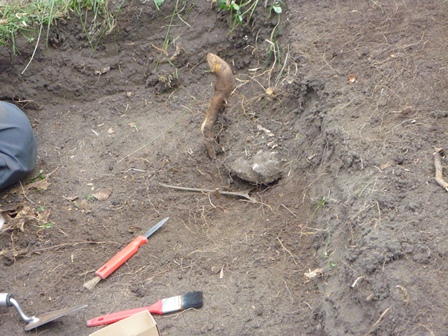 |
|
| A bronze arm ring and horn mount |
The pin being dug out |
|
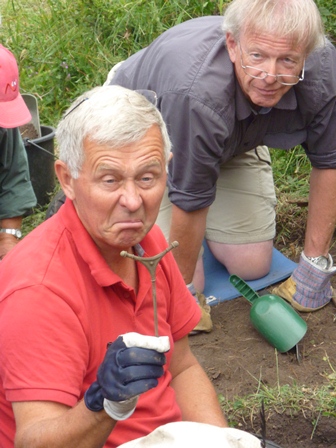 |
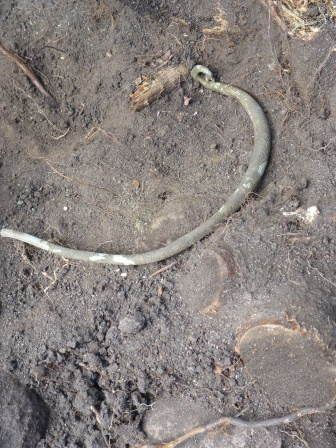 |
|
| The Y shaped pin finally free |
They also found this possible necklace |
|
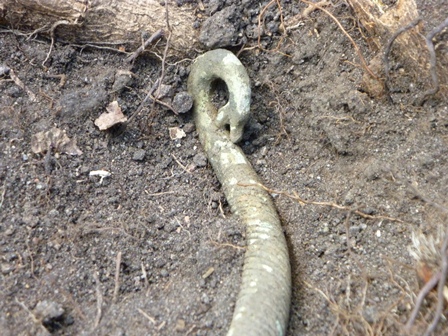 |
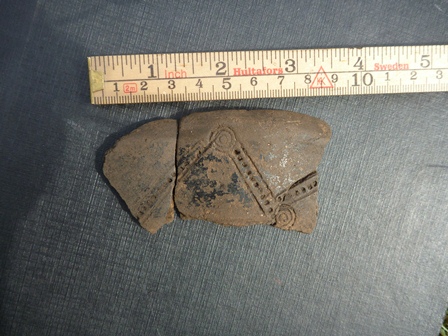 |
|
| One terminal of the necklace |
One of our teams found these three pieces of a
nice pot. |
Today was a half day due to rain. Neil finished digging 16/7
and 17/7 at layer 3, including a lot of work between the rocks.
There were very few finds - mostly ceramics, some more blackware, some
bone but all small pieces (circa 1 cm2). We are going to do
a layer 4 on those squares.
Still no visible layering of the soil, although Karen (in 16/8 and
17/8) and Neil (in 16/7 and 17/7) were getting a massive soft spot
between our squares. About 1.5 m long, running from a point in
the south and widening out to the north (maybe 20 cm wide at the 16 -
17 boundary). The full extent of this won't be known until Karen
finishes 17/8, layer 3. The ground is so soft that if you point the
trowel down and let it go it will sink in an inch. Yet the ground
beside it is very hard to scrape. The folks in 15/7 and 15/8 are seeing
something similar but there it is forming a ring with 10-15cm width
wrapped around a hard core about 30cm wide.
Given that we have bones from at least 3 different rabbits we are
wondering if it is a warren that filled in, or something else.
Perhaps layer 4 will tell us more.
Gustaf Svedjemo's lecture on the Iron Age landscape on Gotland was
rescheduled for the afternoon to make better use of the time.
Unfortunately this fellow was not a good lecturer, which was not helped
by his math heavy thesis, and running about double his allotted
time. He is trying to use predictive analysis on iron-age houses
to understand settlement patterns. Neil is comfortable with the
math showing correlations such as the 84% correlation of iron age stone
houses with moraine based soils - but it is so easy to drift into
assuming that there is causation involved and the math doesn't give you
that. Plus of course, such modeling just confirms what you already
know. It won't point out to you new finds that don't match (and
hence might invalidate) the model involved. He was also very unfocused
in his lecture giving us a broader historical range than his thesis
work would normally involve which didn't help. He went
on long enough we needed a coffee break in the middle.
Neil spent the evening working on the beads, getting the first box (of
3) completed.
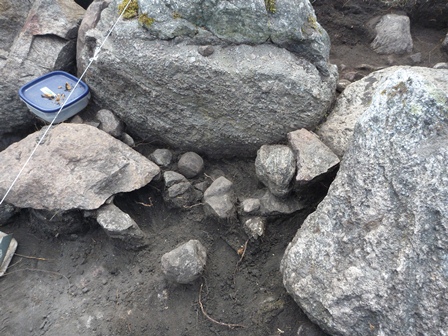
We spent the first part of the morning in a field near Lärbro
looking for possible future dig sites. This field is a good
candidate as the area has everything from stone age to medieval sites
registered but not dug. Then Karen and Neil took off to head into
Visby with Al and Andurs for some shopping and to try to rent Karen a
guitar.
We failed. While we finally got into the music store while they were
open, Karen left frustrated because they refused to rent their guitars.
They said it wasn't worth the trouble for them because it had ended up
costing them too much in repairs when the guitar was returned. They
could have mentioned this policy in the email correspondence that Karen
had had before we even arrived! Karen asked them, if she bought, would
they buy it back from her at the end of the week? The answer was the
same. Not wanting to buy a guitar and treat it like a disposable object
(they suggesting burning it!), Karen opted to walk away.
Karen and Neil toured the town, and met Andurs and Alanna, and two
of the other folks from the dig after dinner. We had borrowed the
school's van for the day so we could give everyone a ride home.
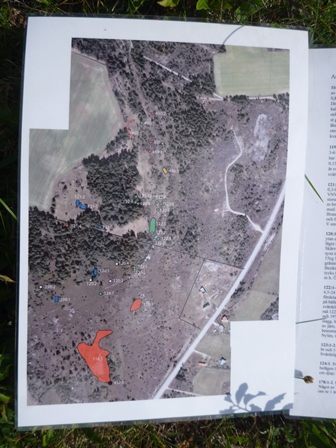 |
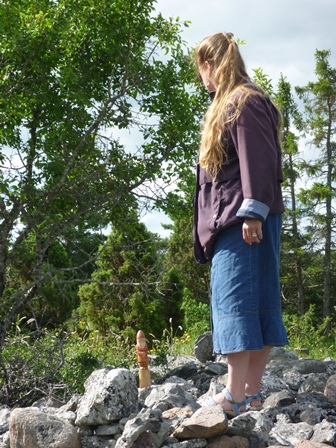 |
|
| Our group focused on trying to spot
stone age grave mounds (the red areas). |
Karen and Snorri found more than a few. | |
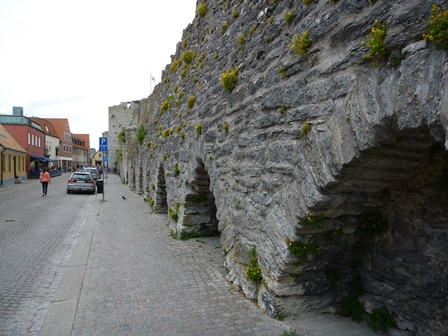 |
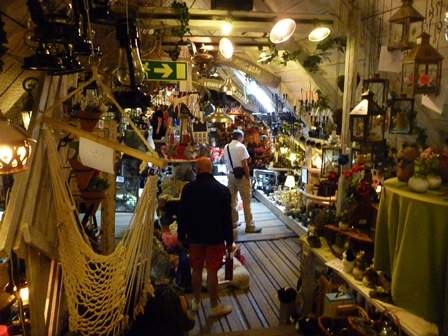 |
|
| The inside of the Visby town wall |
One of the more amusing tourist shops |
|
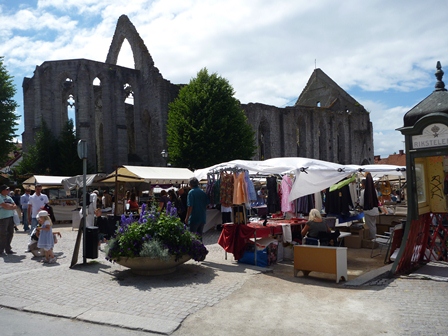 |
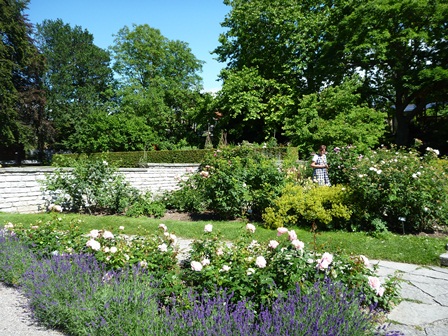 |
|
| The market at Stora Torget |
Botanical gardens, inside the medieval wall |
|
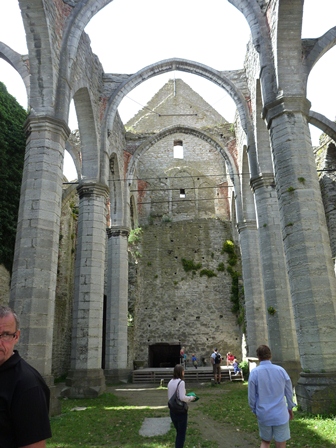 |
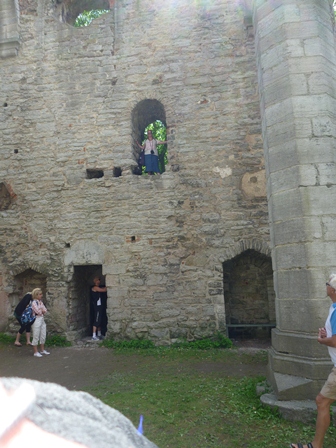 |
|
| St.Katerina - they hold outdoor
concerts here now |
Karen inside one of the church walls |
We finished with a nice dinner at Donners Brunn. Fish and seafood
casserole for Neil - which he still says is a soup. But it did
have huge amounts of seafood and a very tasty broth. Karen had
the lamb. Desert was creme brulee with marinated fruit for Neil
(yummy) and kardemompannacotta (yes spelled that way - sound it out)
with rhubarb sauce for Karen. Also tasty. Then a drive back
to the school with our classmates.
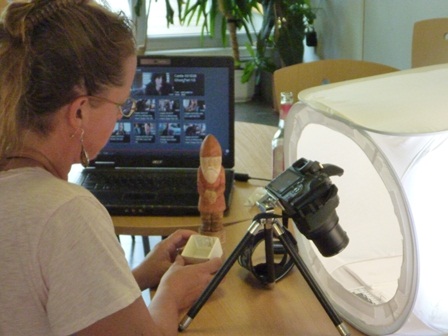 |
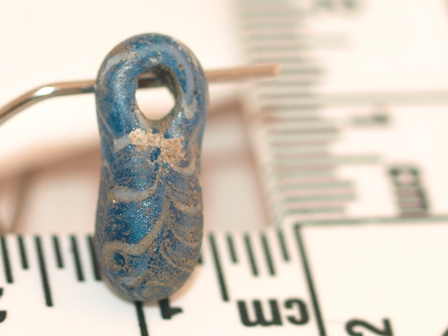 |
|
| Karen and Snorri discussing a bead |
A very odd pendant bead |
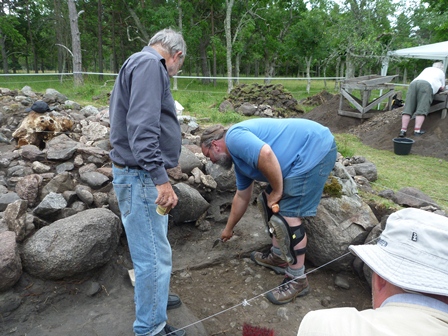 |
| Neil and Dan discussing the hard packed soil. Note that 15/7 where Neil was standing is dug down but 14/7 isn't, you can see the two layers in the transition between the two. |
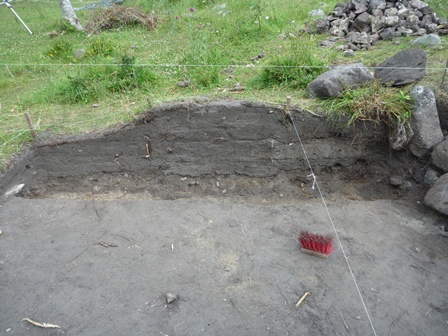 |
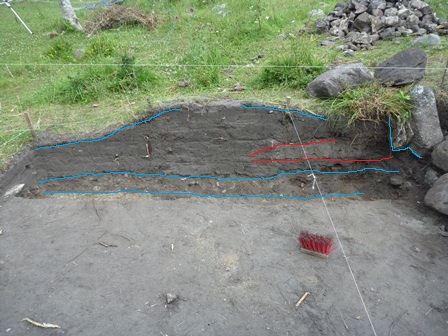 |
|
| Visual profile | Enhanced for those who have trouble seeing the
complex layers |
|
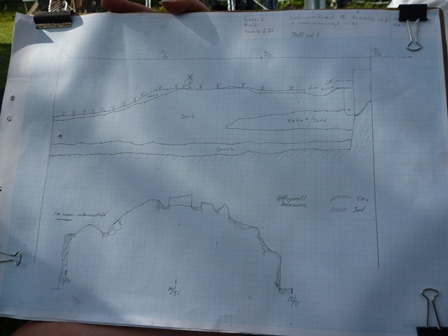 |
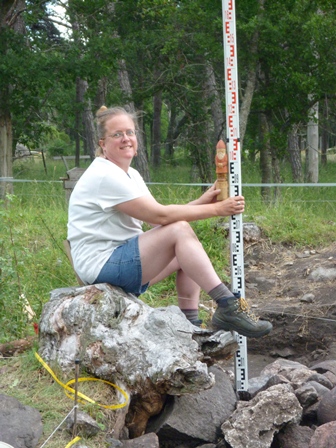 |
|
| Official Profile drawing of the trench and wall cross section | Karen and Snorri helping with the theodolite
measurements |
|
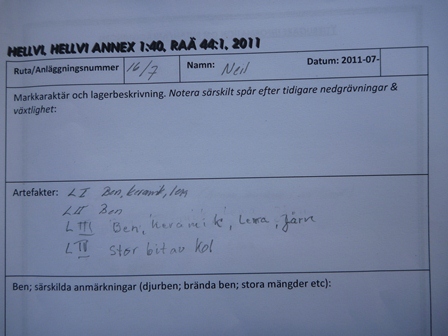 |
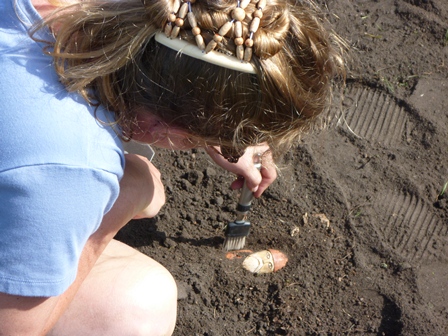 |
|
| Here is an example of the description for one of our squares | Karen did find something interesting at the last minute... |
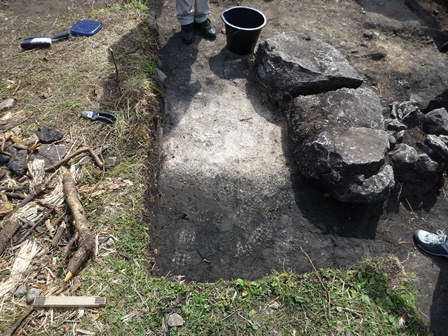 |
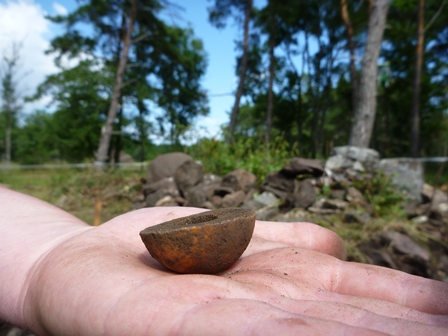 |
|
| An old hearth |
A bone spindle whorl |
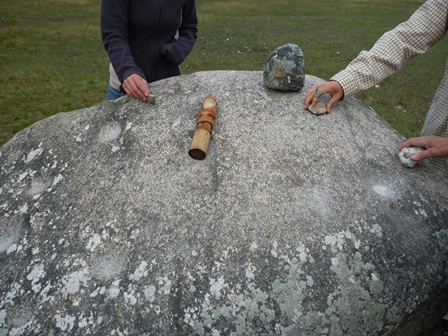
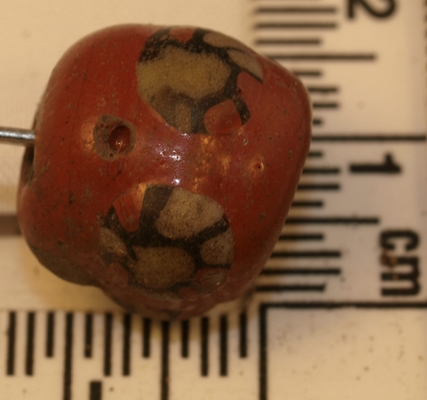 |
 |
|
| A nice decorated bead | And a broken amber bead. Note the hourglass shape of the hole - drilled from both sides. |
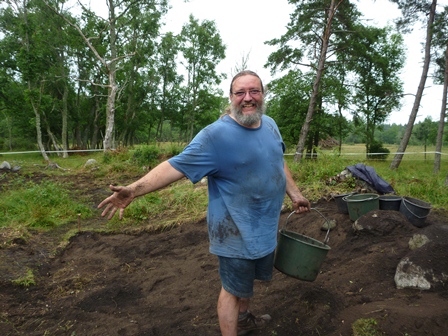 |
| Neil is a dirty boy! |
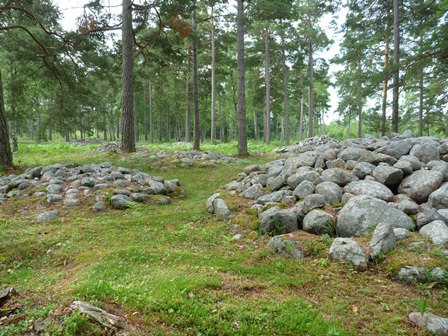 |
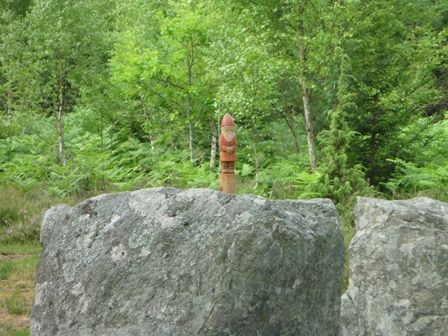 |
|
| Grave mounds |
Snorri stopping on one of the judge stones |
|
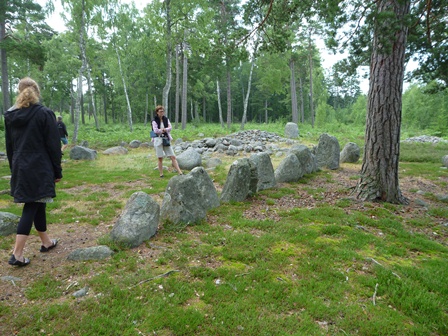 |
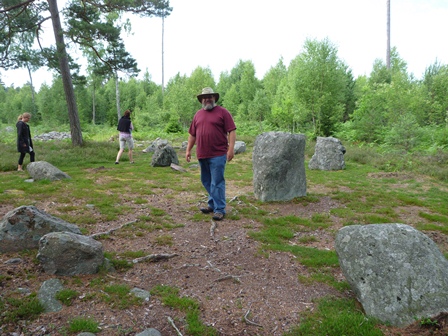 |
|
| A stone path? Part of a boat? |
Neil in one of the judge stone circles |
|
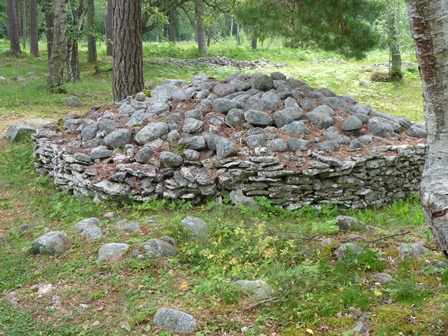 |
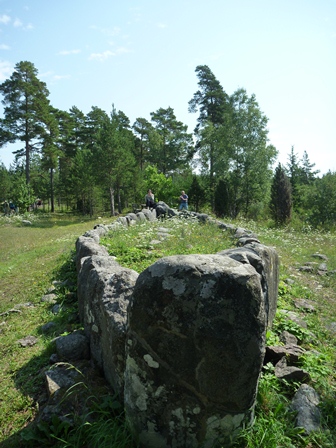 |
|
| Grave mound with a curb |
We
then went to Tjelvar's
grav. Another stone ship |
|
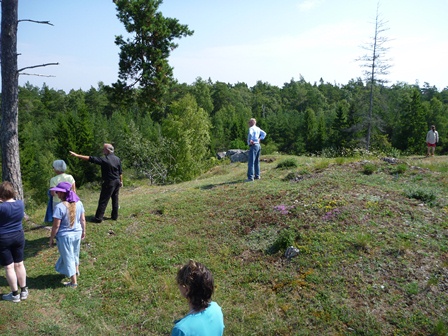 |
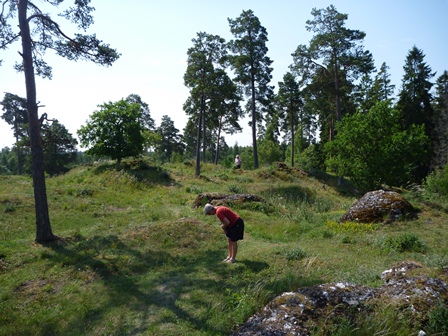 |
|
| And finally Fornborgar - a hill fort. | The view from the other side of the fort |
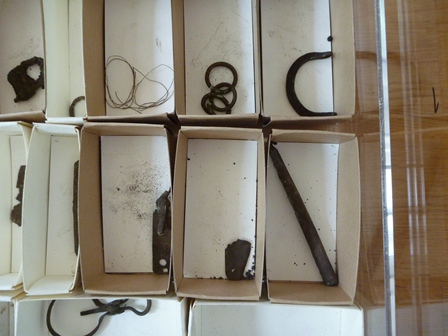 |
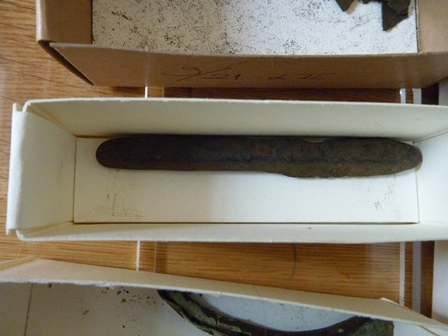 |
|
| Some finds including Karen's needle |
A nice ingot of debased silver |
|
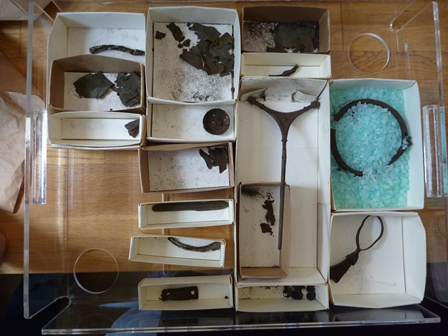 |
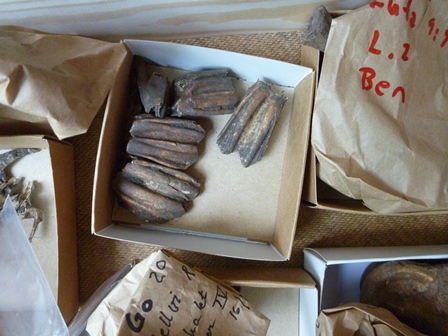 |
|
| More finds including the Y shaped pin |
Horse teeth - one of our more unusual bone finds |
|
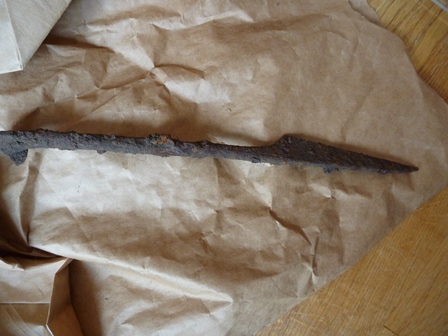 |
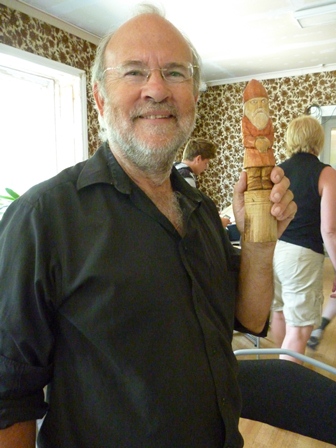 |
|
| Part of a set of sheers |
There were also many good byes said |
 |
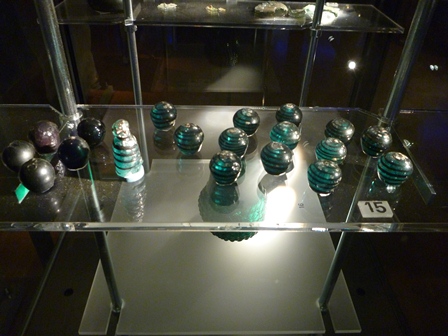 |
|
| These tafl pieces have always interested Neil being made of glass. | Notice the size. The sign
saying "15" is
about a
centimetre tall so the flattened spheres are around 2cm across. |
|
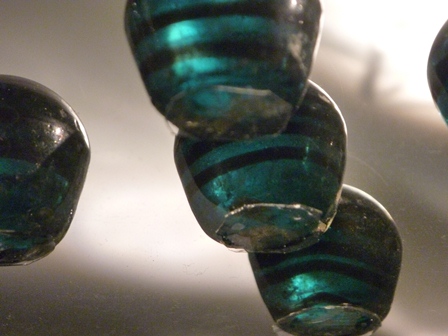 |
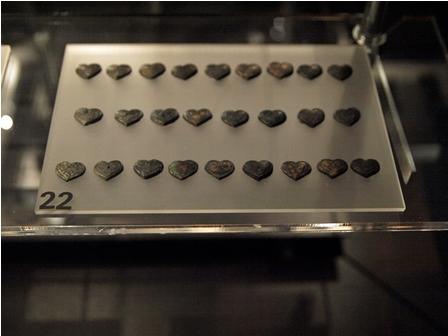 |
|
| It was also nice getting a sort of underneath shot showing no mandrel/peg holes. | These hearts are interesting as we
found one in
the hoard of
silver we dug up. |
|
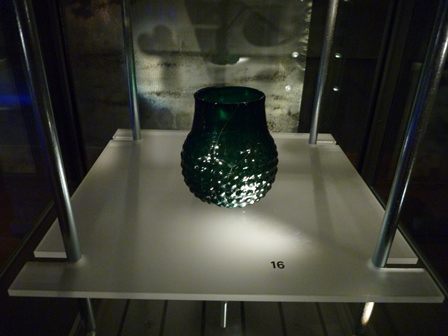 |
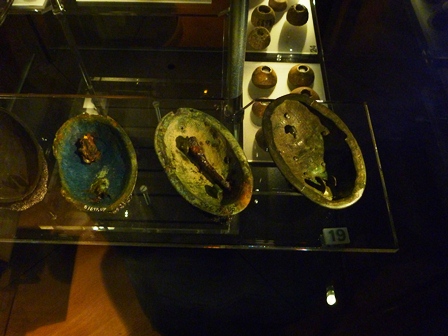 |
|
| Neil has always like this glass beaker from Birka - also bigger than you would think | And Karen was taken by these
broaches shown
upside down to display
fabric impressions and pin connections. |
|
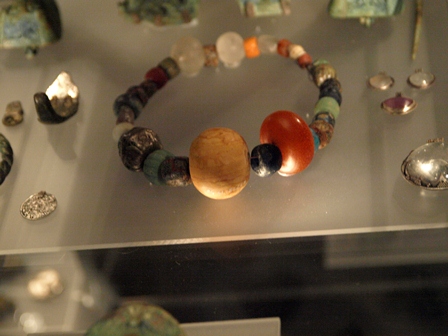 |
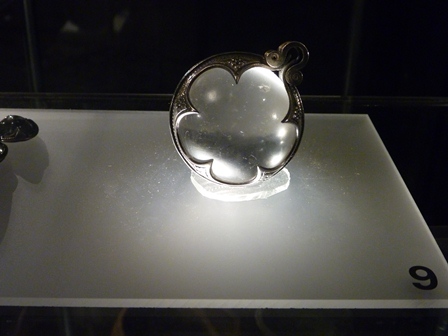 |
|
| Finally a nice necklace with big amber beads. Notice the Gotlandic crystals on the right? There is one made of amethyst. Very cool. | Karen's favourite piece |
 |
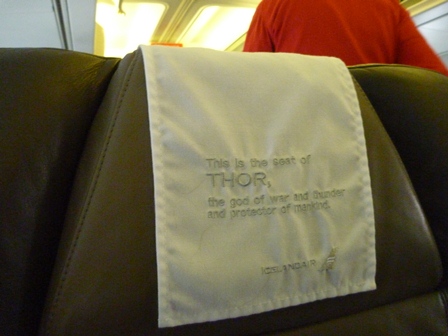 |
| We also got to use the good seats, good thing the owners didn't ask them them back. "Why yes Mr. Thor it DOES have your name on it. No need to use that hammer, I'll move" | |
